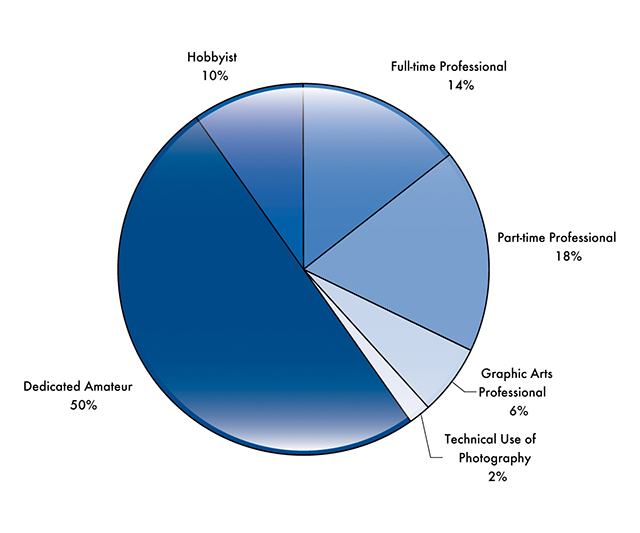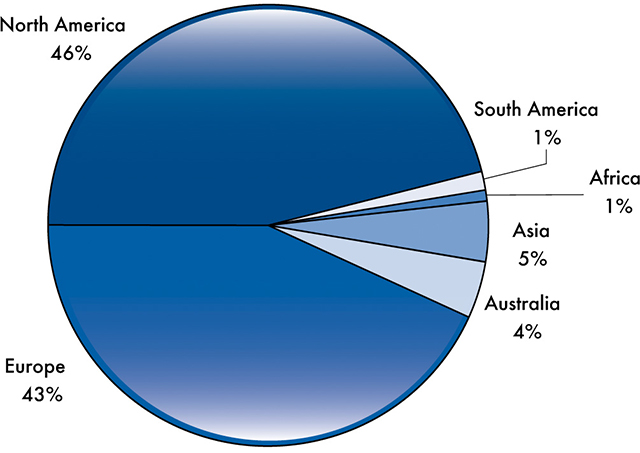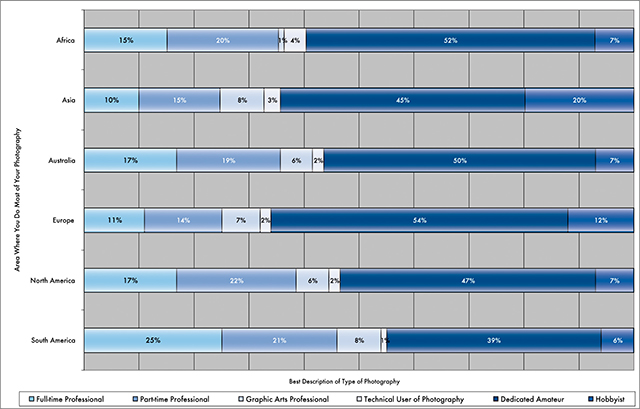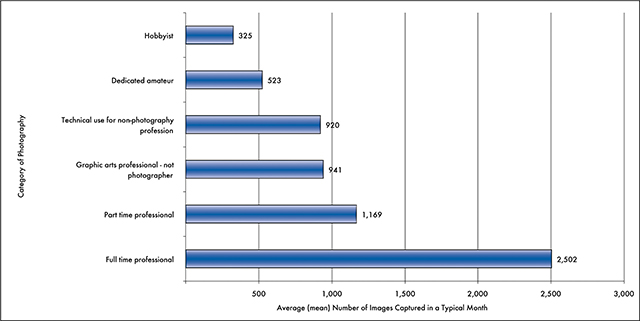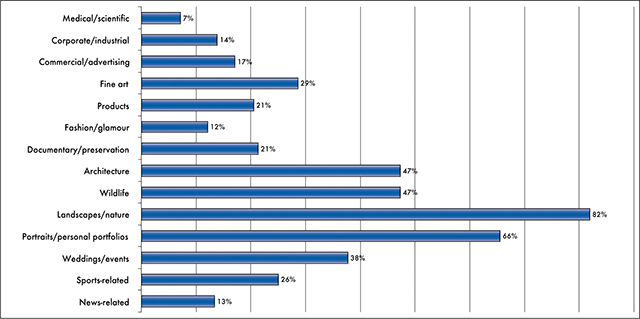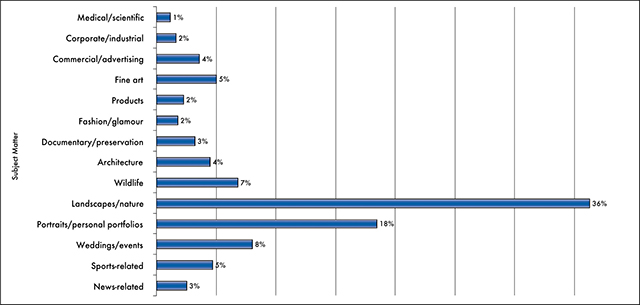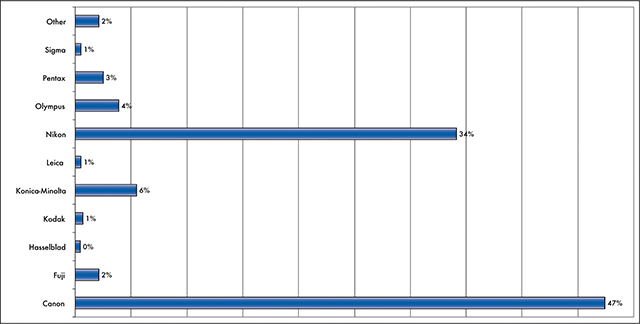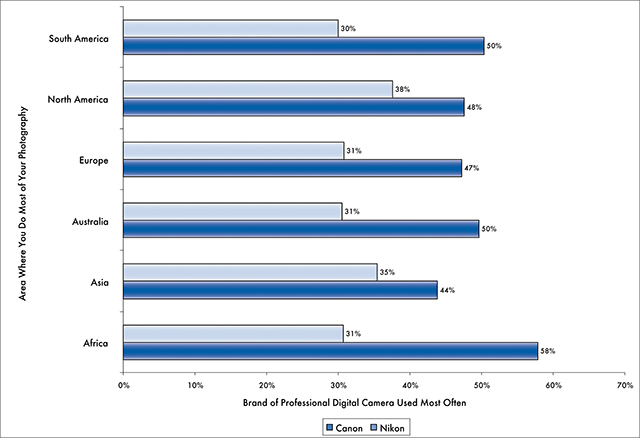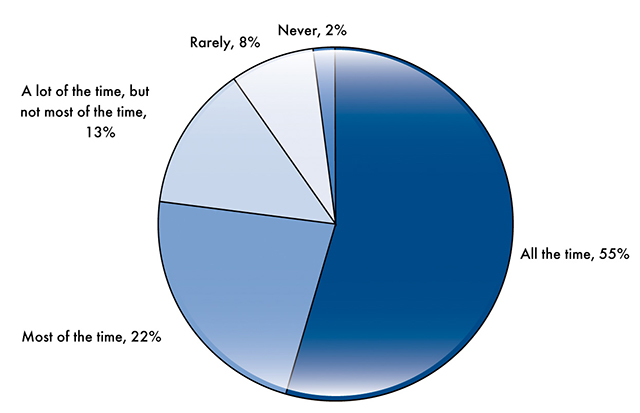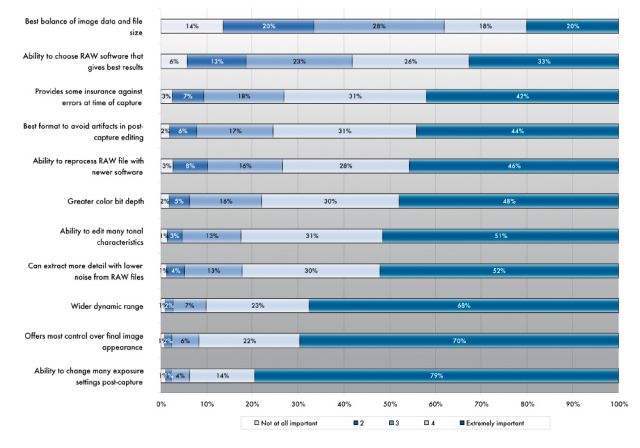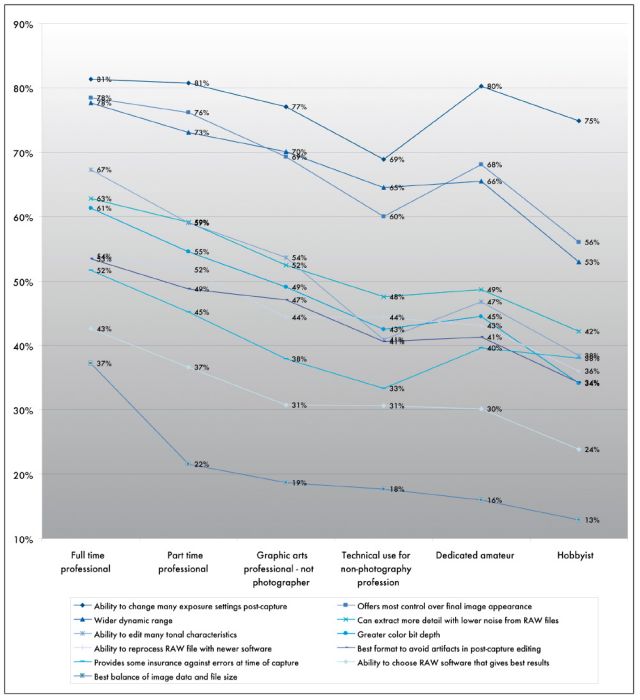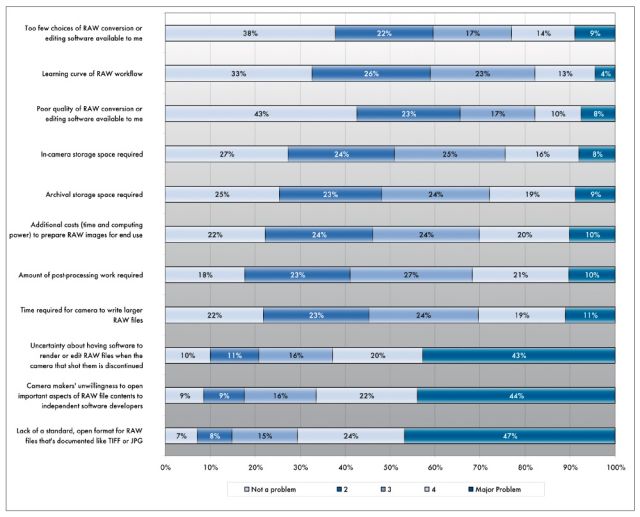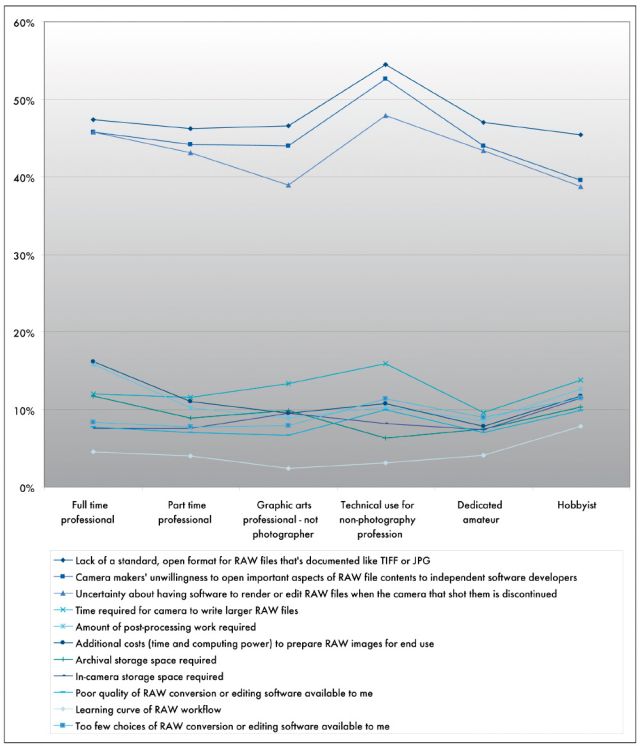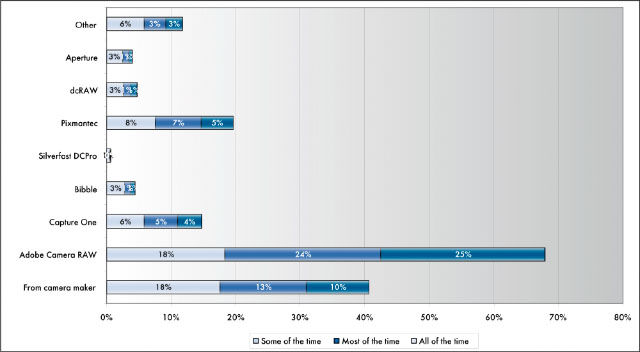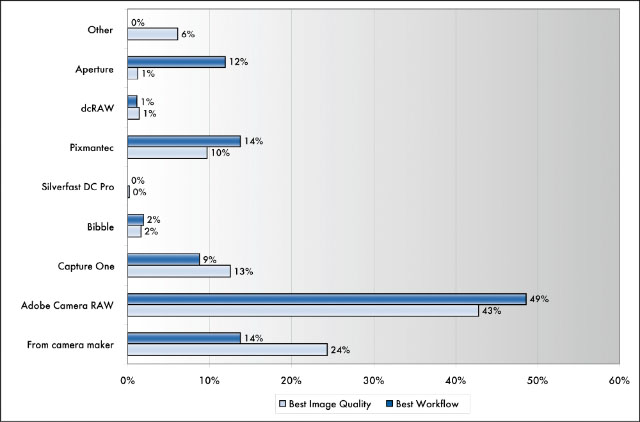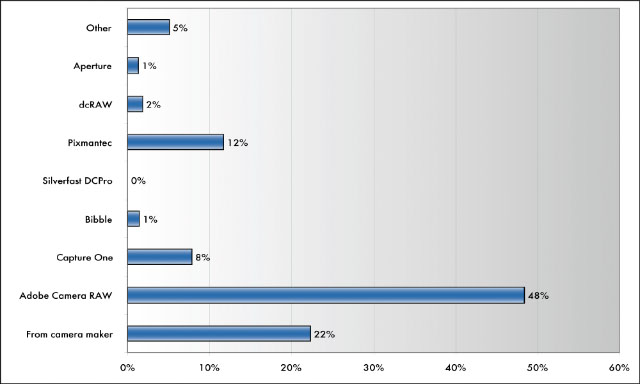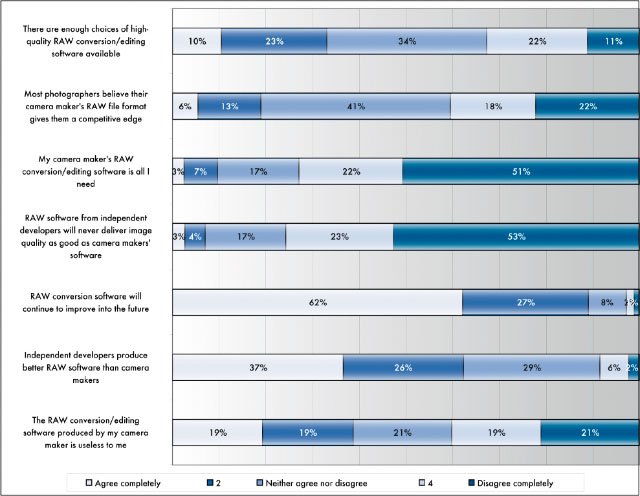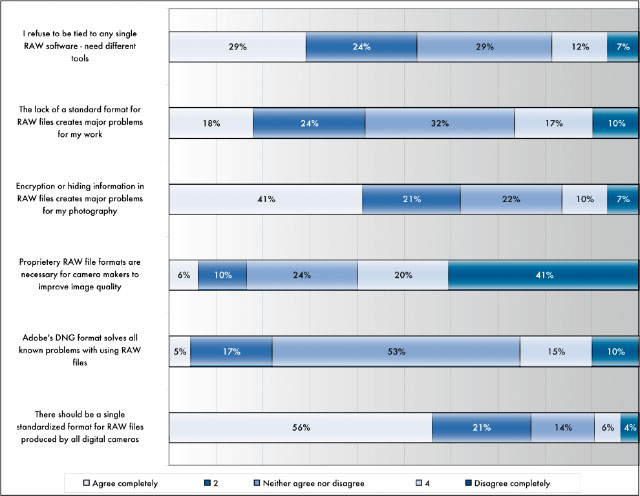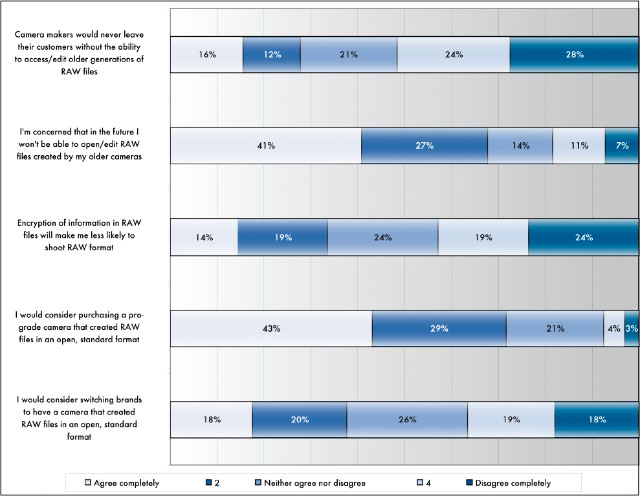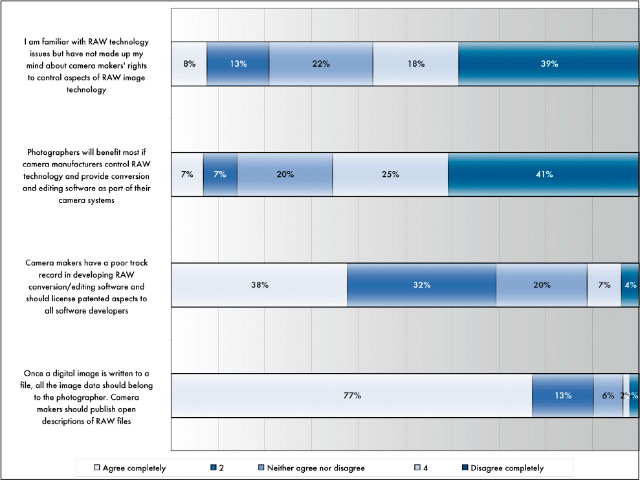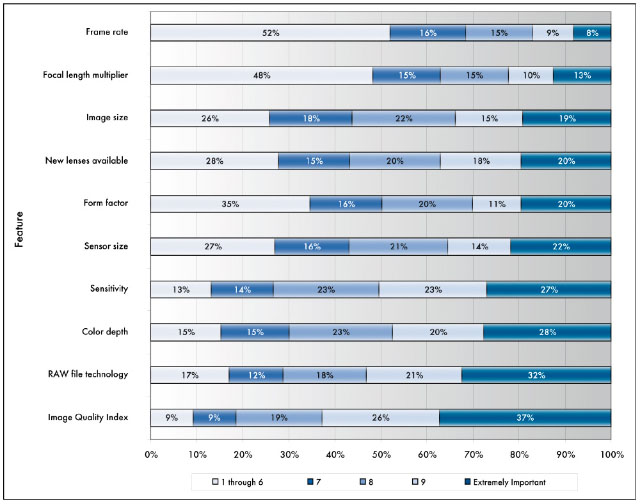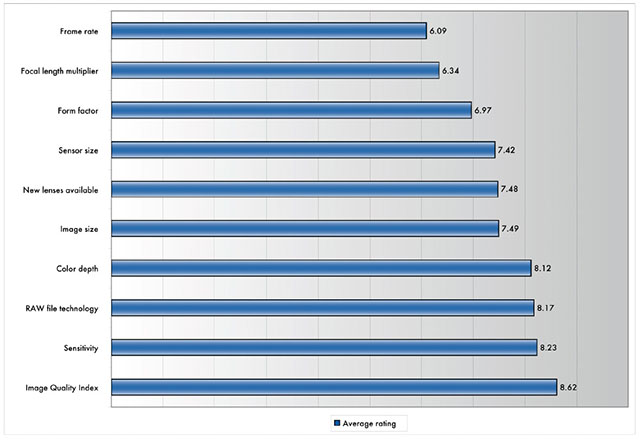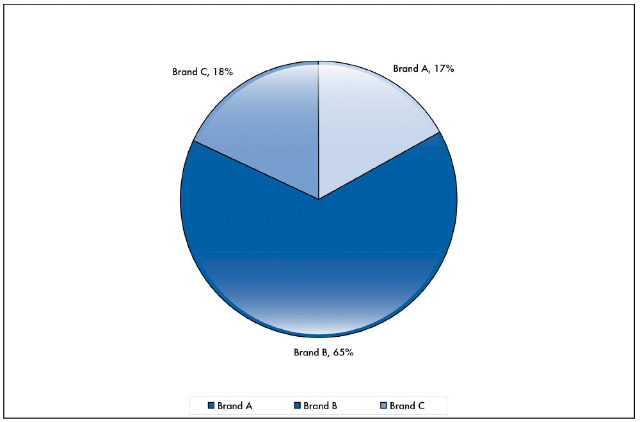The 2006 RAW Survey
The 2006 RAW Survey - A Report on the Experiences, Requirements, Beliefs, and Preferences of Photographers and Imaging Professionals regarding RAW Imaging Technology
The Press Release can be found here. A dedicated Forum has been created to allow readers to discuss the survey results.
2006 RAW Survey Initial Results - Introduction
On January 31, 2006, the Open RAW initiative launched an international survey on its Web site (http://www.openraw.org/survey/) to collect information about the experiences, requirements, preferences, and concerns of digital photographers and other interested parties regarding RAW imaging technology — a concept that many writers are comparing to a "digital negative."
RAW Technology Issues
As the digital properties of RAW image files became better understood, many digital photographers embraced RAW technology as the best means to obtain maximum image quality for themselves and their clients. As the use of RAW image files increases, imaging professionals and devoted amateurs are faced with a proliferation of proprietary RAW formats, often different for each successive camera model from each camera manufacturer. The absence of a robust, common standard for RAW image file formats has resulted in significant disruptions in digital image workflow and limitations in the choice of software tools.
Many photographers, photo archivists, and others involved in digital imaging have become increasingly concerned about the absence of standards for RAW image file formats. The continuing growth in the number of proprietary RAW formats and the adoption by camera manufacturers of the practice of encryption to conceal information stored in RAW image files has increased fears about the viability of RAW formats for long-term archiving of photographic material. Some manufacturers whose cameras produced proprietary RAW files have already gone out of business, with unknown consequences for future access to those images. Many photographers are concerned that RAW files from current camera models may not be accessible in the future when those models become obsolete.
Why a Survey?
Although these topics are being discussed in many photography forums, we have little systematic information about the experiences, requirements, preferences, and concerns of photographers and other users of digital images regarding RAW technology. One thing is clear— many photographers and archivists believe that camera manufacturers are making important decisions about RAW image technology with little or no input from the people who buy and use their equipment or who are involved in the preservation of photographic works. The 2006 RAW Survey was designed to give photographers and other interested parties an opportunity to have a voice in the further development of RAW imaging technology.
Results of the survey will be reported through a series of articles at http://www.OpenRAW.org/. We believe good decisions by the digital photography industry should take account of the requirements, and preferences of the photographers who make their living or pursue their artistic vision through this medium. We will share the survey results openly in the hope that the future of the craft will benefit.
Initial Report on Responses to the 2006 RAW Survey
Our first report provides an overview of the responses to survey questions and how they reflect the attitudes, beliefs, experiences, and preferences of survey respondents on RAW imaging technology and how it affects a hypothetical purchase decision. The initial report is being released in chapters over a period of five days. The chapters are:
- April 25th, 2006 – Chapter 1: Who responded to the 2006 RAW Survey?
- April 26th, 2006 – Chapter 2: Perceptions of the Advantages and Disadvantages of RAW Imaging Technology
- April 27th, 2006 – Chapter 3: Preferences about RAW Image File Conversion and Editing Software
- April 28th, 2006 – Chapter 4: Experiences, Beliefs, and Preferences Concerning RAW Imaging Technology
- April 29th, 2006 – Chapter 5: Preferences among Camera Features in a Hypothetical Camera Purchase Decision
In subsequent reports, we will present additional information on the relationships among responses and offer our interpretations of the possible implications of these relationships for real purchase transactions in the digital marketplace.
Highlights from the 2006 RAW Survey - Chapter 1
Chapter 1. Who responded to the survey?
- A total of 19,207 photographers, digital imaging specialists, and others interested in RAW imaging technology completed the 2006 RAW Survey questionnaire.
- Over 11,200 responses were recorded within three days after the survey was launched. Within one week, nearly 15,000 individuals had participated in the survey. Over 4,200 additional respondents shared their experiences, beliefs, and preferences by the closing date.
- The quality of the response data is exceptionally high. Between 95% and 99% of the respondents answered each question in the survey, which included 25 numbered questions that asked for nearly 100 separate responses.
- A total of 32% of respondents identified themselves as professional photographers (14% full-time and 18% part-time).
- 50% of all respondents classified themselves as dedicated amateurs, and another 10% indicated they were hobbyists.
- 6% of respondents reported they were professionals in the graphic arts – not professional photographers. 2% indicated they used digital imaging for a non-photography profession.
- On average, survey respondents reported:
- 19.4 years experience with film photography
- 4.5 years experience with digital photography
- 3.7 years experience using a professional-level digital camera, and
- 2.3 years experience shooting primarily RAW images.
- Professional photographers reported more years of experience in each of these four activities, but the differences between professionals and dedicated amateurs averaged only about 1 year for each type of activity.
- On average, full-time professional photographers captured about 2,500 digital images per month. Part-time professional photographers averaged over 1,100, while graphic arts professionals and technical users shot over 900 digital images per month. Dedicated amateurs typically captured over 500 digital frames, while hobbyists averaged over 300.
- Most respondents reported doing most of their photography in North America (46%) and Europe (43%). Remaining respondents were from Asia (5%), Australia (4%), Africa (1%), and South America (1%).
- Respondents reported that they photographed a wide range of subject matter, including:
- landscapes or nature (82% of respondents),
- portraits (66%),
- architecture (47%),
- wildlife (47%),
- weddings or events (38%),
- fine art (29%),
- sports-related (25%),
- documentary or preservation (21%),
- products (21%),
- commercial or advertising (17%),
- corporate or industrial (14%),
- news-related (13%),
- fashion or glamour (12%), and
- medical or scientific material (7%).
- The type of subject matter "photographed most often" differed significantly across categories of photographers and other users of photography.
- 8 out of 10 respondents (81%) reported using either Canon (47%) or Nikon (34%) professional-level digital cameras. Other brands were reported by far smaller percentages, including Konica-Minolta (6%), Olympus (4%), Pentax (3%), and Fuji (2%).
- Most survey respondents indicated that they captured digital images in RAW format most of the time. 55% of survey respondents reported that they shot in RAW mode all the time. An additional 22% said they used RAW mode most of the time.
- 83% of professional photographers and 78% of dedicated amateurs said they shot in RAW mode all or most of the time. Only 42% of hobbyists indicated that they used RAW mode all or most of the time.
- Over 80% of respondents who shoot more than 500 images per month, and over 75% of those who shoot between 100 and 500 images per month reported using in RAW mode all or most of the time. Thus, respondents to the 2006 RAW Survey have a great deal of experience with RAW imaging technology.
Highlights from the 2006 RAW Survey - Chapter 2
Section II. Advantages and Disadvantages of Shooting in RAW Mode
What do photographers believe are the benefits of capturing digital images in RAW format?
Survey respondents were asked to rate 11 "potential benefits of shooting in RAW mode for your own photography" using a 5-point scale on which the value "1" meant "Not at all important" up through "5," which meant "Extremely important."
- Over 90% of respondents gave rating scores of "4" or "5" to three of the eleven statements:
- 94% gave ratings of "4" or "5" to "Ability to change many camera exposure settings (such as White Balance, exposure compensation, saturation, etc.) post-capture," with 79% indicating this factor is extremely important.
- 92% gave ratings of "4" or "5" to "Offers the most control over final image appearance," with 70% rating this factor as extremely important.
- 90% gave ratings of "4" or "5" to "Wider dynamic range," and 68% considered this factor extremely important.
- Over 80% of respondents gave rating scores of "4" or "5" to two of the eleven statements:
- 82% gave ratings of "4" or "5" to "Can extract more detail with lower noise from RAW image files," and 52% considered this factor extremely important.
- 82% gave ratings of "4" or "5" to "Ability to edit more tonal characteristics of RAW image files," with 51% indicating this factor is extremely important.
- Over 70% of respondents gave rating scores of "4" or "5" to four of the eleven statements:
- 78% gave ratings of "4" or "5" to "Greater color bit depth," with 48% rating this factor as extremely important.
- 73% gave ratings of "4" or "5" to "Ability to reprocess RAW file again with newer software for improved results," with 46% indicating this factor is extremely important.
- 75% gave ratings of "4" or "5" to "Best image format to avoid artifacts in post-capture editing," and 44% considered this factor extremely important.
- 73% gave ratings of "4" or "5" to "Provides some 'insurance' against errors at the time of capture," with 42% rating this factor as extremely important.
- Two of eleven statements were rated as "4" or "5" by less than 60% of respondents:
- Only 38% gave ratings of "4" or "5" to "Best balance of image data and file size," and only 20% considered this factor extremely important.
- Only 58% gave ratings of "4" or "5" to "Ability to choose RAW software that gives best results for a specific image," with only 33% rating this factor as extremely important. 34% of respondents gave this statement a rating of "1" or "2."
What do photographers believe are the main disadvantages of capturing digital images in RAW format?
Survey respondents were asked to rate 11 "potential disadvantages of shooting in RAW mode for your own photography" using a 5-point scale on which the value "1" meant "Not a problem" up through "5," which meant "Major problem."
- Less than 30% of respondents gave rating scores of "4" or "5" to five of the eleven statements:
- 28% gave ratings of "4" or "5" to "Archival storage space required," with only 9% identifying this factor as a major problem. 25% stated that this factor is not a problem.
- 24% gave ratings of "4" or "5" to "In-camera storage space required," with only 8% reporting this factor as a major problem. 27% reported this factor is not a problem.
- 23% gave ratings of "4" or "5" to "Too few choices of RAW conversion or editing software available to me," with only 9% indicated this factor is a major problem. 38% reported this factor is not a problem.
- Only 18% gave ratings of "4" or "5" to "Poor quality of RAW conversion or editing software available to me," with 8% rating this as a major problem, and 43% indicating this factor is not a problem.
- Only 17% gave ratings of "4" or "5" to "Learning curve of RAW workflow," with 4% indicating this was a major problem, and 33% rating this factor as not a problem.
- At least 30% of respondents gave rating scores of "4" or "5" to three of the eleven statements:
- 30% gave ratings of "4" or "5" to "Additional costs (time and computing power) to prepare RAW images for end use," with 10% rating this factor as a major problem. 22% indicated this was not a problem.
- 31% gave ratings of "4" or "5" to "Amount of post-processing work required," with 10% indicating this factor is a major problem. 18% indicated this factor was not a problem.
- 30% gave ratings of "4" or "5" to "Time required for camera to write larger RAW files," and 11% considered this factor a major problem. 22% stated that this factor was not a problem.
- Over 60% of respondents gave rating scores of "4" or "5" to three of the eleven statements:
- 63% gave ratings of "4" or "5" to "Uncertainty about having software to render or edit RAW files when the camera that shot them is discontinued," with 43% indicating this factor is a major problem. Only 10% of respondents thought this was not a problem.
- 66% gave ratings of "4" or "5" to "Camera makers' unwillingness to open important aspects of RAW file contents to independent software developers," with 44% rating this factor as a major problem. Only 8% reported that this factor was not a problem.
- 71% gave ratings of "4" or "5" to "Lack of a standard, open format for RAW files that's documented like JPG or TIFF," and 47% considered this factor to be a major problem. Only 7% of respondents indicated this was not a problem.
Highlights from the 2006 RAW Survey - Chapter 3
Chapter 3. Preferences about RAW File Conversion and Editing Software
Use of RAW File Conversion and/or Editing Software
Survey respondents were asked how often they used each of eight RAW image conversion or editing software products, and were provided an option to name "other" products not listed in the question. The products listed were "software provided by my camera maker," Adobe Camera RAW," "Capture One," "Bibble," "Silverfast DC Pro," "Pixmantec products," "dcRAW," and "Aperture." Response categories included "all of the time," "most of the time," "some of the time," "rarely," and "never."
- Over 80% of respondents reported they had "rarely" or "never" used four of the eight listed products;
- Only four of the eight named products were used at least "some of the time" by at least 10% of survey respondents:
- Adobe Camera RAW – used by two out of three survey respondents (67%)
- Software provided by the camera maker – used by over two in five respondents (41%)
- Pixmantec products – used by one in five respondents (19%)
- Capture One – used by just over 1 in seven respondents (15%)
- Only about one in twenty respondents (4% to 6%) indicated they used any of the other four listed products (Bibble, Silverfast, dcRAW, and Aperture) at least "some of the time;"
- Of all eight listed products, Adobe Camera RAW was the most likely to be used "all of the time" (25%) and "most of the time" (24%);
- Software "provided by my camera maker" was the next most frequently used product, with 10% indicating they used that type of product "all the time," and 13% indicating "most of the time;"
- About 4% to 5% of respondents indicated they used either Capture One or Pixmantec products "all of the time," and 5% to 7% indicated they used these products "most of the time;"
Perceptions about Image Quality obtained from RAW Conversion/Editing Software
Respondents were asked two questions to determine which of the eight listed software products they believe "delivers the best image quality," and "provides the best workflow" for their photography.
- 43% of respondents indicated that Adobe Camera RAW provided the best image quality, while 49% rated it best for their workflow needs;
- 24% named software from their camera makers as providing the best image quality, but only 14% said this same software provided the best workflow;
- 14% indicated that Pixmantec RAW Shooter products delivered the best image quality, and 10% reported that it gave them the best workflow;
- Similarly, 13% indicated that Capture One gave them the best image quality, while 9% rated it best for workflow;
- Although only 1% of respondents rated Aperture highest for image quality, 12% indicated that it provided the best workflow;
When responses to the two questions are compared:
- Over one-third of respondents (36%) rated two different products as providing the best image quality and the best workflow for their photography. Less than two-thirds of respondents (64%) rated the same software product as best for each of these two purposes.
The 36% of respondents who named different products as "best" for these two purposes were not evenly divided, and proportionately more respondents appear willing to sacrifice image quality for workflow efficiency.
- About 26% of those who selected a given product as providing the best image quality named a different product as providing the best workflow;
- About 10% of those who named a specific type of software as providing the best workflow named a different product as providing the best image quality.
Thus, there are over two and one-half times more respondents who believe they must sacrifice the best image quality in order to obtain the best workflow than believe they must give up the best workflow in order to obtain the best image quality. This comparison reveals that one quarter of all survey respondents believe that they must make a tradeoff between best image quality and best workflow in their own photography.
RAW Conversion/Editing Software Used Most Often
Respondents were also asked which of the eight listed products they used "most often" for their own photography, and allowed to name another product if their preferred software was not listed.
- 48% of respondents named Adobe Camera RAW as the product used most often - the largest percentage naming any product. This matches closely the percentage who rated Adobe Camera RAW as providing the "best workflow."
- 22% of respondents indicated they most often used software provided by their camera makers – making this category of software the second most commonly used. This result matches closely the percentage who rated this type of software as delivering the "best image quality."
- 12% named Pixmantec products as the one they used most often, 8% chose Capture One, only 1% to 2% reported Bibble, Aperture, or dcRAW as most commonly used; 5% of respondents named a long list of "other" products as used "most often," with no specific product named by as much as 1% of respondents.
Adobe Camera RAW (ACR) was most frequently named as the product used "most often" for conversion and/or editing of RAW image files – more than twice as many respondents named ACR (48%) as named software produced by their camera makers (22%). However, that ACR was mentioned by less than half of the respondents further suggests that there is no software solution that a majority of RAW image users identifies as the ideal combination of "best image quality" and "best workflow."
The software RAW image conversion/editing software used "most often" differed across the six types of photographers and image users:
- Professional photographers and graphics arts professionals were more likely than others to name Adobe Camera RAW as the RAW image conversion/editing software they used "most often." ACR was named by 58% of full time pro photographers, 54% of part time pro photographers, and 61% of graphic arts professionals. In comparison, only 45% of dedicated amateurs, 43% of those using digital imaging in a non-photography profession, and 35% of hobbyist photographers used Adobe Camera RAW "most often" for converting/editing RAW files.
These differences reflect the fact that many professional photographers must place a high priority on an efficient workflow to earn a living. Of the eight listed products, Adobe Camera RAW was named as providing the "best workflow" by the largest percentage of respondents. At the same time, over 40% of professional photographers identified a different product (not ACR) as the conversion/editing software they used "most often."
- The percentage that "most often" used conversion/editing software from camera makers was generally lower than the percentage using ACR, and also somewhat less variable across the six groups. About 21% of professional photographers and dedicated amateurs indicated they used camera makers’ software most often, compared to 28% of hobbyists, 24% of technical image users, and only 18% of graphic arts professionals. Relatively small percentages of all categories of respondents indicated a preference for the software provided by their camera makers.
- Professional photographers were also slightly more likely than others to report using Capture One most often (12% full time pros; 9% part time pros).
- Dedicated amateurs (15%) and hobby photographers (16%) were more likely than others (4% to 11%) to report using Pixmantec RAW Shooter products most often.
Highlights from the 2006 RAW Survey - Chapter 4
Chapter 4. Experiences, Beliefs, and Preferences Concerning RAW Imaging Technology
Respondents were asked how much they agreed or disagreed with 18 statements about RAW file conversion/editing software, RAW file conversion/editing workflow, and possible future decisions or choices they might make related to RAW imaging technology.
Perceptions concerning RAW File Conversion/Editing Software
- Exactly one-third of respondents expressed both agreement (33%) and disagreement (33%) with the statement "There are enough choices of high-quality RAW conversion or editing software available." Nearly identical percentages indicated that they "agree completely" (10%) and "disagree completely" (11%). 34% neither agreed nor disagreed – making this the statement in the series on which opinions were most evenly divided.
- Respondents were also evenly divided about the statement, "the RAW conversion or editing software produced by my camera maker is useless to me." 38% agreed, 40% disagreed, and 21% neither agreed nor disagreed. That nearly 40% agreed with this statement indicates that camera manufacturers have failed to convince a large fraction of their customers that their own software is an essential system component for using RAW image files. At the same time, about the same percentage disagreed that the camera makers’ software is "useless," indicating that camera makers have a significant potential customer base for their software.
- About twice as many respondents disagreed (40%) than agreed (19%) with the statement, "Most photographers believe that their camera makers’ proprietary RAW file format gives them a competitive edge." The largest percentage (41%) neither agreed nor disagreed with the statement.
- 76% of respondents disagreed with the statement, "RAW conversion or editing software produced by independent developers will never deliver image quality as good as the camera makers’ own software." Only 7% agreed, and 17% neither agreed nor disagreed.
- Similarly 73% disagreed that "My camera maker’s RAW conversion or editing software is all I need for my photography." Only 10% of respondents agreed, while 17% neither agreed nor disagreed.
- 63% of respondents agreed that "independent developers produce better RAW software than camera manufacturers." Only 8% disagreed with this statement, while 29% neither agreed nor disagreed. These results are consistent with those presented in Chapter 3 where only about one in five indicated that camera makers’ software provided either the best image quality or the best workflow.
- Nearly 90% agreed that "RAW conversion software will continue to improve into the future." Only 3% disagreed with this statement and 8% neither agreed nor disagreed.
Perceptions about RAW File Conversion/Editing Workflow
- Most respondents (53%) agreed that "I refuse to be tied to any single RAW conversion or editing software product; I need different tools for different assignments or clients." 19% disagreed and 29% neither agreed nor disagreed. This finding confirms that most respondents do not believe that any one RAW conversion or editing software product meets all of their photography needs.
- 42% of respondents agreed with the statement, "the lack of a standard format for RAW files creates major problems in my work," compared to only 27% who disagreed, and 33% who neither agreed nor disagreed.
- A substantial majority of respondents (62%) agreed with the statement, "Encryption, hiding, or otherwise attempting to make any information in RAW files unavailable for use by other RAW software creates major problems for my photography," greatly outnumbering those who disagreed (17%) disagreed. 22% neither agreed nor disagreed with this statement.
- In response to the statement, "Proprietary RAW file formats are necessary for camera makers to improve image quality," 61% of respondents disagreed and only 16% agreed, while 24% neither agreed nor disagreed. A substantial majority of respondents does not accept camera makers’ positions that proprietary RAW file formats are essential for image quality to improve.
- A majority of respondents (53%) neither agreed nor disagreed with the statement, "Adobe’s Digital Negative (DNG) format solves all known problems with use of RAW files." Respondents who had formed opinions were roughly equally divided, with 22% agreeing and 25% disagreeing. The DNG solution appears to have generated only modest levels of either acceptance or rejection in the marketplace, with most respondents holding a neutral stance in early 2006.
- Fully 77% of respondents agreed that "There should be a single standardized format for RAW files produced by all digital cameras." Only 10% of respondents disagreed, and 14% neither agreed nor disagreed. Respondents agree far more on a preference for a standardized RAW format than they agree about whether proprietary RAW formats are necessary for improved image quality.
Perceptions concerning Future Choices or Decisions about RAW Imaging Technology
- 52% of respondents disagreed that "camera makers would never leave their customers without the ability to access or edit their older generations of RAW files." Only 28% agreed, and 21% neither agreed nor disagreed. These results reflect awareness that some firms whose cameras produced RAW files in proprietary formats have already ceased production, raising the risk of "orphaned formats."
- 68% agreed with the statement, "I am concerned that in the future I won’t be able to open or edit RAW files created by my older digital cameras," while only 18% disagreed. These results also show that the proliferation of proprietary RAW formats is creating significant concern and discomfort among camera makers’ customers.
- Nearly three-fourths of respondents (72%) agreed with the statement, "I would consider purchasing a professional grade camera that created RAW files in an open, standard format." In comparison, only 7% disagreed, and 21% neither agreed nor disagreed. Among respondents, there is very strong interest in a professional grade digital camera that will produce RAW files in an open, standardized format.
- In addition, 38% agreed with the statement, "I would consider switching brands to have a camera that created RAW files in an open, standard format." An equal percentage (37%) disagreed, while 26% neither agreed nor disagreed.
- Analysis of responses to both of the two prior statements shows that 34% - or about half of the 72% who "… would consider purchasing a professional grade camera that created RAW files in an open, standard format," also "… would consider switching brands …" to achieve that goal. That is, over one-third of all survey respondents (over 6,400 persons) reported that they would consider buying a professional camera that produced RAW files in an open, standard format and might even switch camera brands in order to do so.
It is difficult to over-state the potential importance of this result. There are very few features that camera manufacturers could focus on that would be as likely to affect the future purchasing decisions of customers as the decision to market a professional grade camera that would produce RAW files in an open, standardized format.
Perspectives on Overall RAW Imaging Technology
Respondents were asked about their agreement or disagreement with four general statements about RAW imaging technology.
- 57% of respondents disagreed with the statement, "I am familiar with the RAW technology issues, but I have not made up my mind about camera makers’ rights to control aspects of RAW image technology." Only 21% agreed, and 22% neither agreed nor disagreed.
- 67% of respondents disagreed that "Photographers will benefit most if camera manufacturers control RAW technology and provide conversion and editing software as part of their camera systems." Only 14% agreed, and 20% neither agreed nor disagreed. A large majority of respondents clearly rejected camera makers’ position that proprietary RAW imaging technologies are beneficial features of their "total imaging systems."
- Moreover, 70% agreed with the statement, "Camera makers have a poor track record in developing RAW conversion and editing software that meets photographers’ needs. They should license patented aspects of their RAW technology to all software developers for reasonable fees." Only 11% disagreed, and 20% neither agreed nor disagreed. Most respondents do not believe that camera makers can or will provide software equal in quality to their camera hardware.
- Finally, 90% of respondents agreed that "once a digital image is written to a file by a camera, data in all parts of the image file should belong to the photographer who captured the image. Camera makers should publish full and open descriptions of all parts of the RAW image files their camera produce." Only 4% of respondents disagreed with this statement, and only 6% neither agreed nor disagreed.
Respondents have exceptionally strong opinions on this topic. Camera makers that do not recognize and take account of these perceptions are at significant potential risk that their customers may decide to make future equipment purchases from firms that share their views and values concerning the information stored in RAW image files.
Highlights from the 2006 RAW Survey - Chapter 5
Chapter 5.Preferences among Camera Features in a Hypothetical Camera Purchase Decision
Ratings of Factors that May Affect Camera Purchase Decisions
Part III of the 2006 RAW Survey asked a series of questions about the relative importance of several performance features that photographers typically weigh when considering purchase of a new professional grade digital camera system, including:
- Form Factor: 35mm SLR form vs. medium format
- Sensor Size: the dimensions of the imaging sensor expressed in millimeters
- Image Size: the size of the image files expressed in megapixels
- Color Depth: the number of bits per channel of color data
- Focal length multiplier: the focal length or field of view factor compared to 35mm standards
- Frame Rate: the number of images recorded per second
- Sensitivity: the sensitivity of the imaging chip expressed in ISO values for "noiseless" images
- New lenses available: the number of new lenses that would take advantage of all camera features
- Image Quality Index: a fictional new rating of overall image quality expressed on a 100-point scale
- RAW Technology: whether RAW image files are written in proprietary vs. open, standard format
Each of three hypothetical camera "brands" was given a unique combination of these 10 factors that typically differentiate advanced digital camera systems (see http://openraw.org/2006rawsurvey/originalsurvey/). Respondents were then asked to rate the importance of each of the 10 factors for making a decision about which of the three hypothetical camera systems to "purchase." Ratings were made on a 10-point scale, where "1" meant "Not at all important," and "10" meant "Extremely important."
- Two of the factors were rated significantly lower than the other eight. About half the respondents gave scores of 6 or below to "frame rate" (52%) and "focal length multiplier" (48%). Only 8% indicated that "frame rate" was "extremely important" (a score of 10), and only 13% gave the highest rating to "focal length multiplier."
- Four of the factors show relatively higher (and relatively similar) rankings. Between 26% and 35% gave scores of 1 through 6 to "image size" (26%), "new lenses available" (28%), "form factor" (35%), and "sensor size" (27%). Between 31% and 38% of respondents rated these four factors with scores of "9" or "10" (extremely important), with between 19% and 22% rating all four as "extremely important."
- Three factors, "sensitivity," "color depth," and "RAW technology," also showed similar and higher rating patterns. Few respondents gave these factors low scores (in the 1 to 6 range) – 13% for "sensitivity," 15% for "color depth," and 17% for "Raw technology." Moreover, about half of respondents – 50% for "sensitivity," 48% for "color depth," and 53% for "RAW technology" – gave all three dimensions scores of "9" or "10" (extremely important), with 27% to 32% rating all three factors as "extremely important."
- Among the ten factors, "Image Quality Index" (a fictional, independent rating of overall image quality on a 100-point scale) stood out from the others. Only 9% rated "Image Quality Index" with scores in the 1 to 6 range, and 63% rated it as "9" or "10" (extremely important). Nearly two in five (37%) rated "Image Quality Index" as "extremely important."
In summary, three of the 10 factors received average scores between 6 and 7, three factors received average scores between 7 and 8, and four factors received average scores between 8 and 9 on the 10-point rating scale. The "frame rate" factor received the lowest average rating (approximately 6 on a 10-point scale), while "Image Quality Index" received the highest average rating, over 8.6 on the 10-point scale.
The relative order of importance of the factors is roughly the same for all six types of photographers and imaging professionals. For most (but not all) of the factors, average ratings given by professional photographers are slightly higher than those given by other categories, but the differences are relatively small.
Most Important Reasons for Selecting a Specific Brand in a Hypothetical Camera Purchase Decisions
When asked which of the three hypothetical new camera systems they would "purchase," nearly two-thirds of respondents (65%) indicated a preference for Brand B. Considerably smaller and nearly identical fractions chose Brand A (17%) and Brand C (18%). The factors considered "most important" for the hypothetical purchase decision differed considerably for respondents who "bought" each of the three models.
- For the 17% who selected Brand A, the "sensor size" (24x36mm or "full-frame 35mm equivalent) was identified as most important by over one-third (36%), and "Image Quality Index" score was named as most important by 29%. These two factors were named by nearly two-thirds (65%) of those who preferred Brand A. Only 1% to 9% named any of the other eight features as most important for their decision.
- Among the 18% who "purchased" Brand C, it’s top ranking "Image Quality Index" score was cited as the most important reason by 54% of respondents. Another 19% named "sensor size" as most important (Brand C was the only model of the three to have a sensor measuring 80mm by 80mm). Finally, "image size" (88 megapixels) was considered most important by 12%. These three factors were named by 85% of those who preferred Brand C. Each of the other seven features was named as most important by only 0% to 6% of this group.
- The 65% of respondents who chose Brand B named three factors as most important to their hypothetical purchase decision: "RAW image technology" by 38% (Brand B was described as having the most open RAW imaging technology), "sensitivity" by 22% (lowest noise over the widest ISO range), and "Image Quality Index" by 10% (the IQI score of 90 was lowest of the three hypothetical brands). A total of 70% of Brand B "purchasers" named these three factors as "most important." The other seven features were named by only 1% to 7% of those who selected Brand B.
Most Important Reasons for Rejecting Brands in the Hypothetical Camera Purchase Decision
Respondents were asked to identify which of the 10 camera features was the most important reason that they chose not to "purchase" each of the two camera models that they rejected. In each case, respondents who "purchased" a specific hypothetical brand had distinctly different reasons for rejecting each of the other two brands.
Reasons for Rejecting Brand A
- Among the 65% of respondents who preferred Brand B, 75% indicated their most important reason for rejecting Brand A was its "RAW image technology." Brand A was described as having the most proprietary RAW technology of the three hypothetical brands, with features designed to ensure that Brand A buyers would have difficulty using RAW conversion/editing software other than that provided by the manufacturer of Brand A. The other nine factors were mentioned by only 1% to 6% of Brand B purchasers.
- Respondents that "purchased" Brand C (18%) were somewhat more divided in their descriptions of the most important reason they rejected Brand A. 46% indicated "Raw image technology," 21% named "Image Quality Index," 11% identified "image size," and 10% reported "sensor size," as being their most important reasons for rejecting Brand A.
Reasons for Rejecting Brand B
- Among the 17% who preferred Brand A, 38% cited "sensor size," 24% named "Image Quality Index," 11% indicated "focal length multiplier," and 10% mentioned "RAW image technology" as their most important reasons for rejecting Brand B.
- For the 18% who preferred Brand C, two factors predominated. Nearly one half of these respondents (45%) rejected Brand B for its inferior "Image Quality Index" score, while one-quarter (26%) rejected Brand B because of its smaller sensor size.
Reasons for Rejecting Brand C
- For respondents who "purchased" either Brand A (17%) or Brand B (65%), the medium "format factor" was the reason cited most frequently for rejecting Brand C.
- Many who favored Brand A also rejected Brand C because of the large "image size" (17%) and the large "sensor size" (12%).
- Among the 65% who chose Brand B, the second most frequently cited reason for rejecting Brand C was its RAW image technology (25%). In addition, 10% of Brand B "purchasers" rejected Brand C for its large "image size."
Possible Implications of Respondents’ Preference for Hypothetical "Brand B"
The largest percentage of respondents who preferred Brand B in the hypothetical purchase decision indicated that their choice was influenced by Brand B’s "RAW image technology," which included:
- Open RAW file format
- Documentation to be provided to the public (including independent software developers) at no cost
- Brand B’s manufacturer does not offer RAW conversion or editing software
Brand B’s RAW imaging technology was cited as the most important reason for the hypothetical purchase more often than any other factor for any of the three cameras.
Most respondents – 25% of 18,385 who answered all questions in this section of the survey – identified the open, documented RAW imaging technology as the single factor that was most important to their selection of Brand B above the two other brands.
No other single factor was cited by more than 15% of respondents. In this hypothetical purchase framework, RAW imaging technology clearly dominated all other individual features with respect to its potential impact on future purchases.
We believe the results reported here should be considered carefully by camera makers and software producers as they continue to develop both the technologies and the marketing strategies for the new systems they offer to the next generation of prospective customers.
The 2006 RAW Survey - Chapter 1
Chapter 1. Who responded to the 2006 RAW Survey?
Between January 31 and March 15, 2006, a total of 19,207 photographers and others involved in creating and using digital images responded to the 2006 RAW Survey. Although the long survey period was allowed to ensure that all interested people would have an opportunity to contribute to the data set, most respondents completed the questionnaire in a much shorter time period. By the end of the third day after launch (February 2), 11,259 responses had been received – nearly 59% of the final total. By the time one week had elapsed (February 6), 14,965 individuals had responded (78% of the total received). Keeping the survey questionnaire available for five additional weeks allowed 4,242 additional participants to add their perspectives and experiences to the data base.
The Quality of the Response Data
The 2006 RAW Survey questionnaire was developed and tested over a period of two months. Over 150 photographers and imaging specialists volunteered their time to test and recommend improvements to early versions. The final Web-based questionnaire included 25 numbered items, but about half of the survey items included multiple questions or asked respondents to “check all that apply.” The result was that survey participants typically provided between 75 and 100 separate responses. Very few survey participants skipped over or declined to answer the survey questions. To provide a few typical examples:
- only 30 respondents (0.2%) did not answer Question #2 (“How often do you capture digital images in RAW mode?”);
- 595 respondents (3.1%) did not answer question #7 (“Which of the following RAW file conversion or editing software products do you use most often?”);
- 669 respondents (3.5%) did not answer question #12 (“Considering all ten factors, which camera system would you be most likely to purchase?”);
- 532 respondents (2.8%) did not answer question #21 (“What type of subject matter do you shoot most often?”);
- and only 437 respondents (2.8%) did not answer the final item (“Please indicate the area where you do most of your photography.”).
In fact, only 2 items in the entire questionnaire were missing responses from as much as 5% of the survey participants – questions that asked respondents’ views about which RAW conversion or editing software products provided the best image quality (question #8) and provided the best workflow (question #9). In summary, between 95% and 99.8% of the 19,207 survey participants answered each question, a remarkable result. The survey sponsors greatly appreciate the time and effort contributed by everyone who completed the questionnaire.
Characteristics of Survey Participants
Several of the questions in the 2006 RAW survey asked for information about respondents’ backgrounds and characteristics, such as:
- the best description of their involvement with photography now;
- the numbers of years involved in film photography, digital photography, using a professional-grade digital camera, and capturing digital images in RAW mode;
- the area where they do most of their photography;
- the number of images captured with a digital camera in an average month;
- the types of subject matter captured most often; and
- the brands of professional digital cameras used most often.
Our primary reason for including these questions was to be able to determine whether experiences and opinions about RAW imaging issues would vary across different types of respondents. However, answers to these questions also provide a broad overview of the characteristics of the people who responded to the survey.
This is especially important because it is not feasible to conduct a study like the 2006 RAW Survey with a true “random sample” of all photographers and others interested in RAW image technology. Because survey respondents volunteered to complete the questionnaire in response to announcements and press releases, we cannot claim that the respondents are “representative” of all photographers or imaging specialists because of our sampling methods.
However, the answers to the survey questions about background characteristics can help readers to make their own judgments about whether the survey results appear reasonable, or instead appear to represent the experiences, attitudes, beliefs, and preferences of 19,207 individuals who are – in some way – very different from typical, mainstream photographers and imaging professionals who use digital cameras to make their livings or pursue other creative visions or professional interests.
As shown in Chart 1 below, survey respondents comprised a mix of professional and amateur photographers as well as other types of users of RAW digital images. In response to Question 16, a total of 32% of respondents identified themselves as professional photographers (14% full-time and 18% part time). Another 6% reported they are professionals in the graphic arts that used RAW images, but were not themselves photographers. Only 2% of respondents indicated they used photography in support of other professions, such as science or medicine. Half (50%) of all survey respondents described themselves as dedicated amateurs, and 10% indicated that photography was a hobby.
Chart 1. Percentage Distribution for “Best Description
of Your Involvement with Photography Now”
Experience with film photography, digital photography, professional cameras, and shooting RAW
Overall, survey respondents reported having considerable experience with both film photography (average of 19.4 years) and digital photography (average of 4.5 years), using professional digital cameras (average of 3.7 years), and shooting in RAW mode (average of 2.3 years). Table 1 below shows the average (mean) number of years reported for each of these activities for each of the six categories of involvement with photography or digital imaging.
Table 1. Average (mean) Years of Experience Reported with
Film Photography, Digital Photography, Using a Professional-level Digital Camera,
and Shooting Images in RAW Mode
| Category | Film Photography |
Digital Photography |
Professional Digital Camera |
Shooting in RAW Mode |
|---|---|---|---|---|
| Full-time Professional |
20.7 | 5.5 | 5.5 | 3.1 |
| Part-time Professional |
19.6 | 4.7 | 4.3 | 2.5 |
| Graphic Arts Professional |
17.3 | 5.1 | 3.6 | 2.2 |
| Technical User of Photography |
23.7 | 5.7 | 4.4 | 2.7 |
| Dedicated Amateur |
19.8 | 4.3 | 3.1 | 2.0 |
| Hobbyist | 14.9 | 3.7 | 2.2 | 1.6 |
Area where respondents do most of their photography
Survey respondents lived and worked in all parts of the world. However, as shown in Chart 2, 89% of respondents reported working in North America (46%) and Europe (43%). Photographers and imaging professionals in Africa, Asia, Australia, and South America are thus considerably under-represented among respondents to the 2006 RAW Survey. Limiting the survey questionnaire to English only may explain the lower proportions of respondents from Africa, Asia, and South America. The numbers of respondents from Australia is consistent with the response pattern from Europe and North America.
Chart 2. Area Where Respondents Do Most of Their Photography
Chart 2 shows clearly that our survey participants include large numbers of respondents from Europe and North America, and include relatively few from the Africa, Asia, and South America. Does this make the survey results highly suspicious or even useless? The answer depends on whether photographers in Africa, Asia, and South America would have given significantly different answers to the survey questions than those given by their counterparts in Australia, Europe, and North America. Below, and throughout this report, we will show the responses to questions given by respondents from all six areas so that readers can judge whether the overall survey results we report might have been different if there were more participants from Africa, Asia, and South America.
For example, Table 2 and Chart 3 show the percentages of respondents who classified themselves into the six professional and amateur categories within each of the six locations. The two professional categories comprised between 35% and 46% of the respondents from Africa, Australia, North America and South America, but made up only 25% of the respondents in Asia and Europe. Dedicated amateurs and hobbyists ranged from 45% to 59% in Africa, Australia, North America, and South America, but were 65-66% of the respondents in Asia and Europe.
Table 2. Best Description of Your Involvement with Photography
Now within Area Where You Do Most of Your Photography
| Category | Africa | Asia | Australia | Europe | North America | South America | All Areas |
|---|---|---|---|---|---|---|---|
| Full-time Professional |
15% | 10% | 17% | 11% | 17% | 25% | 14% |
| Part-time Professional |
20% | 15% | 19% | 14% | 22% | 21% | 18% |
| Graphic Arts Professional |
1% | 8% | 6% | 7% | 6% | 8% | 6% |
| Technical User of Photography |
4% | 3% | 2% | 2% | 2% | 1% | 2% |
| Dedicated Amateur |
52% | 45% | 50% | 54% | 47% | 39% | 50% |
| Hobbyist | 7% | 20% | 7% | 12% | 7% | 6% | 10% |
| Total | 100% | 100% | 100% | 100% | 100% | 100% | 100% |
Chart 3. Best Description of Type of Photography by Area Where You Do Most of Your Photography
Average Number of Digital Images Captured in a Typical Month
The first survey question asked participants for an estimate of the number of images they captured with their digital camera in an average month . Respondents who indicated they were full-time professional photographers reported they captured an average of just over 2,500 digital images per month. Those who classified themselves as part-time professionals reported capturing an average of 1,169 digital images per month – only slightly more than the graphic arts professionals and those who use digital imaging for non-photography professions who reported averages of 941 and 920 images per month, respectively. The averages for the three latter groups were roughly double the average number of images reported by dedicated amateurs, and between three and four times the average reported by hobbyists.
Chart 4. Average Number of Images Captured per Month by Type of Involvement with Photography
By the time of the 2006 RAW survey, most respondents are likely to have created many thousands (in some cases many tens of thousands) of images in a variety of RAW formats. Our survey respondents are not passive observers of developments in RAW imaging technology – they have a great deal at stake in the ultimate outcome and are using their survey responses to express their views on issues that matter a great deal to them.
Types of Subject Matter Photographed
Survey respondents were asked to indicate the types of subject matter they photographed using a list of 14 broad categories. Over 18,700 respondents gave a total of 82,170 responses, indicating that, on average, respondents reported photographing between 4 and 5 different types of subjects. Chart 5 below shows that at least 25% of respondents reported that they photographed seven of the types of subject matter listed (fine art – 29%, architecture – 47%, wildlife – 47%, landscape/nature – 82%, portraits – 66%, weddings – 38%, and sports-related material – 25%).
Chart 5. Types of Subject Matter Photographed
When asked to indicate the single type of subject matter they photographed most often , 36% of respondents indicated landscape/nature material, followed by portraits (18%), weddings/events (8%), and wildlife (7%), with fine art, architecture, and sports at about 5% each.
Chart 6. Type of Subject Matter Photographed Most Often
The type of subject matter photographed most often differed significantly across self-reported category of photographer as shown in Table 3 below. Full-time professional photographers were most likely to report photographing commercial/advertising subjects (18%) as well as weddings/events (14%), portraits (12%), and news-related material (9%). Full-time professionals are significantly more likely than other categories to shoot commercial/advertising and news-related materials. Part-time professionals were most likely to report shooting landscapes/nature (23%), portraits (17%), weddings/events (14%), sports-related material (8%), and fine art (7%). Graphic arts professionals who are not photographers were most likely to report using landscape/nature subject matter (28%), portraits (17%), fine art materials (11%), architecture (9%), products, (6%) and commercial/advertising materials (6%). Those who use digital images in their non-photography professions were most likely to report photographic medical/scientific subject matter (32%), as well as landscapes/nature (20%), material for documentation or preservation (11%), and corporate/industrial subjects (7%). Dedicated amateurs and hobbyists reported very similar preferences, with nearly half of both groups reporting they most often photographed landscapes/nature (48-49%), portraits (20-25%), and wildlife (8-9%).
Table 3. Type of Subject Matter Photographed Most Often within Categories of Photographer
| Full time professional |
Part time professional |
Graphic arts professional - not photographer |
Technical use for non- photography profession |
Dedicated amateur |
Hobbyist | Total | |
|---|---|---|---|---|---|---|---|
| News- related |
9% | 4% | 2% | 1% | 1% | 0% | 3% |
| Sports- related |
5% | 8% | 2% | 2% | 4% | 3% | 5% |
| Weddings/ events |
14% | 14% | 5% | 1% | 5% | 7% | 8% |
| Portraits/ personal portfolios |
12% | 17% | 17% | 8% | 20% | 25% | 18% |
| Landscapes/ nature |
8% | 23% | 28% | 20% | 49% | 48% | 36% |
| Wildlife | 2% | 6% | 3% | 7% | 9% | 8% | 7% |
| Architecture | 5% | 3% | 9% | 6% | 4% | 4% | 4% |
| Documentary/ preservation |
3% | 4% | 5% | 11% | 3% | 2% | 3% |
| Fashion/ glamour |
4% | 4% | 2% | 1% | 1% | 0% | 2% |
| Products | 6% | 3% | 6% | 3% | 1% | 1% | 2% |
| Fine art | 5% | 7% | 11% | 2% | 4% | 1% | 5% |
| Commercial/ advertising |
18% | 3% | 6% | 1% | 0% | 0% | 4% |
| Corporate/ industrial |
7% | 2% | 2% | 7% | 0% | 0% | 2% |
| Medical/ scientific |
1% | 1% | 1% | 32% | 0% | 1% | 1% |
Brands of Professional Digital Camera Used
Survey respondents were asked what brand of professional digital camera they used most often. More than four in five (81%) reported using two major brands of digital SLR – Canon (47%) and Nikon (34%). Konica-Minolta ranked a distant third, with 6% claiming to use that brand most often. The other seven listed brands were reported by 1% to 4% of respondents. A total of 362 (2%) reported using “other” brands not listed among the response categories (e.g., Leaf, Sinar, Contax, Mamiya, Phase One, and a variety of others).
There were few differences from the preferences shown in Chart 7 across the six categories of photographers or imaging professionals. From 44% to 49% reported using Canon cameras most often, except for those using digital imaging for non-photography professions, where only 42 percent preferred Canon. Similarly, from 33% to 39% reported using Nikon cameras most often, except for hobbyists, where only 29% preferred Nikon.
Chart 7. Brand of Professional Digital Camera Used Most Often
We compared the percentage that reported using the two most frequently named brands (Canon and Nikon) across the six continental areas; the results are shown in Chart 8. The percentages using each of the two brands are remarkably similar across areas, with the exception of Africa, where the preference for Canon is higher than in the other five areas. This difference may arise from the fact that the survey was completed by only 142 respondents who reported doing most of their photography in Africa. Small samples typically lead to greater variability in survey results.
Chart 8. Brand of Professional Digital Camera Used Most Often
by Area Where You Do Most of Your Photography
Frequency of Capturing Digital Images in RAW Mode
Question #2 in the survey asked: “How often do you capture digital images in RAW mode?” Chart 9 below displays the percentage of respondents who chose each of the five response categories.
Chart 9. Frequency that Respondents Capture Digital Images in RAW Mode
Over half of the respondents (55%) indicated that they captured images in RAW format “all the time.” An additional 22% reported that they used RAW mode “most of the time.” Thus nearly four in five respondents to the 2006 RAW Survey (77%) capture images in RAW format most or all of the time. There is little question that respondents to this survey have a great deal of experience with RAW image technology.
To confirm this, we examined the responses about the relative frequency of RAW mode shooting within five groups denoting the average number of digital images captured in a typical month and display the results in Table 4.
Table 4. Frequency of Shooting RAW Mode by Average Number of Images Captured per Month
| All the time | Most of the time | A lot of the time, but not most of the time |
Rarely | Never | Total | |
|---|---|---|---|---|---|---|
| 100 or fewer | 46% | 25% | 15% | 11% | 4% | 100% |
| 101 to 250 | 52% | 25% | 14% | 7% | 2% | 100% |
| 251 to 500 | 56% | 22% | 13% | 8% | 1% | 100% |
| 501 to 1,000 | 60% | 21% | 11% | 6% | 1% | 100% |
| More than 1,000 | 60% | 20% | 13% | 7% | 1% | 100% |
Table 4 shows that the differences in the relative frequency of shooting in RAW mode differ only slightly depending on the average number of digital images captured per month. About 80% of respondents in the two highest volume categories (“501 to 1,000” and “More than 1,000” images per month) reported shooting in RAW mode “all” or “most of the time.” Fully 60% of respondents in both these categories reported using RAW mode “all the time.” Only slightly less – 77% to 78% – of those who typically shoot lower volumes (“101 to 250” and “250 to 500” images per month) reported using RAW mode “all” or “most of the time.” Over half (52% to 56%) of the respondents in these two categories capture images in RAW format “all the time.” Even among the 3,905 respondents who reported shooting “100 or fewer” images per month, 71% indicated that they shoot in RAW mode “all” or “most of the time,” and almost half (46%) always use RAW mode.
Table 5 shows a similar breakdown of relative frequency of shooting in RAW mode by the six categories of photography or other imaging professional. The patterns are also similar to those in the breakdown on average shooting volume. Over 80% of both categories of professional photographers shoot in RAW format “most” or “all the time,” with about 60% using RAW mode “all the time.”
Table 5. Frequency of shooting RAW Mode by Type of Involvement with Photography
| All the time | Most of the time | A lot of the time, but not most of the time |
Rarely | Never | Total | |
|---|---|---|---|---|---|---|
| Hobbyist | 6% | 36% | 23% | 26% | 8% | 100% |
| Dedicated amateur | 56% | 22% | 13% | 8% | 2% | 100% |
| Technical use | 37% | 28% | 22% | 11% | 3% | 100% |
| Graphic arts professional | 47% | 25% | 18% | 9% | 1% | 100% |
| Part-time professional | 59% | 23% | 12% | 5% | 1% | 100% |
| Full time professional | 62% | 21% | 11% | 5% | 1% | 100% |
Between 65% and 78% of graphic arts professionals, those who use digital photography in other professions, and dedicated amateurs also shoot in RAW format “most” or “all the time.” Only in the category of hobbyists (containing 1,179 respondents) do we find that less than half reported shooting in RAW format “most” or “all the time.” Only 6% of this group reported shooting in RAW mode “all the time,” and over one-third (34%) indicated that they “rarely” or “never” used RAW mode.
These tables strongly support the conclusion that the vast majority of survey respondents have a great deal of experience with RAW imaging technology.
The additional analyses presented below demonstrate that respondents to the 2006 RAW Survey choose to shoot in RAW mode for a wide variety of reasons believed to support and improve the quality of the images they are able to produce. They are also aware of numerous problems and obstacles with using RAW technology and have a variety of perspectives concerning the potential impact of these problems and drawbacks and the best ways to deal with them.
The 2006 RAW Survey - Chapter 2
Chapter 2. Perceptions of the Advantages and Disadvantages of RAW Imaging Technology
The 2006 RAW Survey questionnaire included many questions that focused on the experiences, opinions, beliefs, and preferences of photographers and others who use RAW imaging technology. This chapter presents a preliminary review of the responses to these questions.
The Advantages of RAW Imaging Technology
Question #3 of the survey instrument asked: "Using a 5-point scale where "1" means "Not at all important" and "5" means "Extremely important", please rate the following potential benefits of shooting in RAW mode for your own photography." Chart 10 below shows the distributions of responses to the 11 "potential benefits" listed in this question.
Chart 10. Perceived Importance of Potential Benefits of RAW Image Files
Of the 11 potential benefits listed, all but one ("balance of image data and file size") were viewed as "very important" by at least 33% of survey respondents.
Among all potential benefits, "the ability to change many exposure settings … post capture" was the factor that most respondents (79%) considered to be "extremely important." In fact, 93% of respondents ranked this item with values "5" (extremely important) or "4."
Next in priority, 68% to 70% of survey respondents indicated that "wider dynamic range" and "offers most control over final image appearance" to be "extremely important." Over 90% of respondents chose response categories "4" or "5" (extremely important") for these two items.
The ability "to extract more detail with lower noise" and "to edit many tonal characteristics" were considered "extremely important" by more than 50% of respondents, and to be "important" (given ratings of "4" or "5" by over 80% of respondents.
Four of the "potential benefits" listed were ranked as "extremely important" by between 40% and 50% of respondents (between 70% and 80% rated these items as "4" or "5"). These items included, "greater color bit depth," "ability to reprocess RAW files with newer software," "best format to avoid artifacts in post-capture editing," and "insurance against errors at time of capture."
Significantly, the item "ability to choose RAW software that gives the best results" was considered an "extremely important" benefit by only 33% of respondents (compared to 79% who gave the same high rating to "ability to change many exposure settings post-capture"). This indicates to us that while the ability to change some exposure settings is considered an exceptionally important property of RAW technology, the ability to choose RAW software to change those exposure settings is not seen as an important advantage by many respondents. One interpretation of this finding is that photographers see the potential of changing exposure settings as extremely important, but that the current RAW technology implementation – including the differences in rendering that result from different software packages - creates obstacles to choosing and using RAW software, thus making the most important benefit of RAW technology less available than photographers would prefer. We present more survey results on this question in the following sections.
Finally, providing the "best balance of image data and file size" was viewed as a "very important" advantage by only 20% of survey respondents. We may conclude from these responses that, compared to factors related to image quality, the potential logistic benefits associated with RAW image formats (e.g., reduced storage requirements compared to, say, uncompressed TIFF files) is not a feature of RAW image technology that most respondents believe is the key benefit of shooting in RAW mode.
Chart 11 below displays the percentage of each of the six categories of photographer/imaging specialists that rated each of the eleven potential benefits of shooting in RAW mode as "extremely important." The chart shows that the percentage that rate "ability to change most exposure settings" as "extremely important" varies from about 81% of professional photographers down to 69% of "technical users," and to 75-80% of amateurs/hobbyists. Despite these differences, all six categories of photographers/image users rate this potential benefit higher than the next two potential benefits (control over final image appearance and wider dynamic range). In turn, these two potential benefits are both rated higher by all six categories of photographer/image specialist than the next six potential benefits. Further, these six factors are considered by all six photography categories to be more important than "ability to choose RAW software that gives best results," which is, in turn, considered more important by all categories to be more important than the "balance of image data vs. file size."
Although there is variation across types of photographers in the percentages who consider each potential benefit levels to be "extremely important," the eleven potential benefits of shooting in RAW mode are given roughly the same "rank order" by all photographers, regardless of their professional or amateur status.
Chart 11. Percentage of Respondents in Six Photography User Categories that Rate each of 11 Potential Benefits of RAW Images as "Very Important"
Disadvantages of Shooting RAW
Question 4 in the survey asked: "Using a 5-point scale where "1" means "Not a problem," and "5" means "Major problem," please rate the following potential disadvantages of shooting in RAW mode for your own photography." Chart 12 below displays the percentages who chose each "problem level" for each of the 11 potential disadvantages.
Chart 12. Ratings of Eleven Potential Disadvantages of RAW Image Technology
Eight of the 11 potential disadvantages listed were rated as a "major problem" by less than 12% of the respondents (the first eight factors listed in Chart 9 above). Moreover, less than 1/3 of survey respondents gave these eight factors rating scores of "4" or "major problem."
Between 59% and 66% of respondents ranked three of the listed "potential disadvantages" as either "not a problem" or "2" on the five-point scale – "Too few choices of RAW conversion or editing software available to me," "Learning curve of RAW workflow," and "Poor quality of RAW conversion or editing software available to me."
Between 41% and 51% of respondents gave "Not a problem" or "2" ratings to the next five factors, including "In-camera" and "archival" storage space required, "Additional costs (time and computing power) to prepare RAW images for end use," "Amount of post-processing work required," and "Time required for camera to write larger RAW files."
Conversely, three of the eleven potential disadvantages were rated as "major problems" by more than 40% of respondents – "Uncertainty about having software to render or edit RAW files when the camera that shot them is discontinued" (43%), "Camera makers’ unwillingness to open important aspects of RAW file contents to independent software developers" (44%), and "Lack of a standard, open format for RAW files that’s documented like TIFF or JPG" (47%). Each of these three items was given a score of "4" or "Major Problem" by between 63% and 71% of survey respondents. It is clear from these patterns that the majority of respondents consider the main disadvantages of using RAW image technology to arise from their concerns about the risks inherent in proprietary RAW file formats.
Chart 13 displays the percentage of respondents who rated each of the 11 potential disadvantages as a "Major problem" for each of the six categories of photographer or imaging specialist.
Chart 13. Percentage That Rate Eleven Potential Disadvantages of Shooting RAW as a "Major Problem" by Categories of Photography Users
Chart 13 makes clear that there are few differences across categories of photographers or imaging specialists in the degree to which they ranked each of the 11 potential disadvantages of shooting RAW as a "Major Problem." Much larger percentages of all six categories rate the three factors related to proprietary RAW file formats as a "major problem" compared to the other eight factors related to either logistical matters (storage, time consumed, etc.) or the greater time or technical demands of a RAW workflow.
The 2006 RAW Survey - Chapter 3
Chapter 3. RAW Image File Conversion and Editing Software
Use of RAW File Conversion and/or Editing Software
Survey Question #6 asked: "How often do you use each of the following RAW image conversion or editing software products?" Eight products were listed in the question, and respondents were also allowed to specify an "Other" product. Chart 14 displays the percentages of respondents who indicated that they used each of the nine products (including "other") "some of the time," "most of the time," or "all of the time." The response categories "rarely" and "never" are not shown in the table. In fact, over 80% of respondents reported they had "never" or "rarely" used seven of the nine products (including "other") listed in the question.
Chart 14. Percentage of Respondents that Use Listed RAW Conversion/Editing Software Packages
For four of the listed products (Bibble, Silverfast, dcRAW, and the newly-released Aperture), very few respondents (5% or less) used them at least "some of the time." Less than 2% of respondents used any of these four products either "all" or "most of the time." Overall, about 15% of respondents reported using any form of Phase One’s Capture One products, with under 10% indicating they used it "all" or "most of the time." RAW Shooter products from Pixmantec were used by nearly 20% of respondents, with about 12% indicating they used it "all" or "most of the time." "Other" products were named by only 12% of respondents, with only half of these (6%) indicating they used the "other" product "most" or "all of the time."
Only two of the listed products – software produced by the respondents’ camera makers and Adobe’s Camera RAW were used at least "some of the time" by substantial numbers of respondents. Just over 40% indicated that they used software from their camera makers, with just under one-quarter (23%) reporting they used these products "most of the time" (13%) or "all of the time" (10%). Two-thirds of respondents (67%) reported using Adobe Camera RAW, with nearly half of respondents indicating they used ACR "most of the time" (24%) or "all of the time" (25%).
Respondents were also asked two questions to determine which of the listed software products they believe [1] "delivers the best image quality," and [2] "provides the best workflow" for their photography. Chart 15 shows the response distributions for these two questions.
The percentages in Chart 15 should not be interpreted as if all respondents are necessarily making experience-based comparisons among all the listed products. For example, some respondents may have no experience with some of the software products, while others may have decided against using certain products based on careful evaluation and comparisons among them. Despite these limitations on interpretation, about 95% of respondents believed they had sufficient information about the listed products to indicate which one they believed was best for each of the two purposes.
Moreover, we believe this limitation on the interpretation of the response patterns is not a significant disadvantage. Very few photographers or imaging specialists will have the interest or the resources to carry out extensive direct comparisons of all software products under ideal conditions. This fact does not prevent them from forming perceptions and/or making choices among software products based on other information, such as product reviews or the opinions and/or recommendations of colleagues, teachers, and other trusted resources. That said, the results presented here should be interpreted in the context of both the limitations of the survey design and the limitations, as described above, in respondents’ exposure to the listed software products.
Chart 15. Percentage That Believe Each of the Listed Software Products Provides
Them with "The Best Image Quality," and "The Best Workflow"
With respect to image quality, most respondents (43%) indicated that Adobe Camera RAW provided the "best image quality" for their photography. This percentage is significantly higher than for all other software products, including software from respondents’ camera makers (24%), and independent developers such as Phase One’s Capture One (13%), Pixmantec products (10%), and "Other" named products (6%). Less than 3% of respondents indicated that Bibble, Silverfast DCPro, dcRAW, or Aperture provided the "best image quality." We cannot determine whether the ratings for these four products results from low market penetration, or because they have been evaluated by respondents and rejected for regular use.
Most respondents (49%) also reported that Adobe Camera RAW provided them with the "best workflow" for handling RAW images. This percentage is also far higher than for any other listed software product, including software from camera makers (14%), Pixmantec (14%), Aperture (12%), and Capture One (9%). Similar to the image quality ratings, less than 3% of respondents mentioned either Bibble, Silverfast, dcRAW, or their own named "other" product as providing the "best workflow."
The percentages shown in Chart 15 reveal that respondents have somewhat different views of the strengths of the software products that they’ve used. For example, if we compare the percentages of respondents who name each product for the "best image quality" and the "best workflow," we see that larger percentages of respondents indicate that Adobe Camera RAW, Pixmantec products, and Aperture provide the "best workflow" than say these products deliver the "best image quality." Conversely, respondents are more likely to report that software from camera makers and Capture One provides the "best image quality," than they are to indicate that those products provide the "best workflow." (This also appears to be true of respondents who named "other" software products.)
The differences in percentages of respondents that report a given software product provides the "best image quality" versus "best workflow" is, to a significant degree, an indication that respondents believe they must make tradeoffs to achieve their personal goals (or those of their clients). As we will see in additional analyses presented below, the desire for software that combines "best image quality" and "best workflow" is a source of frustration that we believe is reflected in the opinions expressed in response to other questionnaire items.
Chart 16 displays the percentage of respondents that indicated that they used each of the nine software products "most often" for converting or editing their RAW image files. The pattern is similar to that shown in Chart 14, although that chart reflects that most respondents reported using more than one software product.
Chart 16. Percentage That Report Using Each Listed Software Product "Most Often"
Nearly half of all respondents (48%) reported that Adobe Camera RAW was the software product they used most often. Software from respondents’ camera makers were the next most commonly mentioned as the product used "most often" (22%) – but less than half the percentage that named ACR as their "most often" used software. About 12% of respondents named Pixmantec products, followed by 8% who specified Capture One, and 5% who named an "other" product.
Among 2006 RAW Survey respondents, Adobe Camera RAW was clearly the product most commonly chosen for conversion and/or editing of RAW image files. However, ACR was mentioned as the product used "most often" by less than half of the respondents. This suggests that there is no software solution that dominates the perceptions of RAW image users for both "best image quality" and "best workflow." Many photographers and imaging specialists are interested in a better solution than the market now offers them.
Table 6 displays the percentage of respondents that identified each software package as the one they used "most often" separately for the six categories of photography users. Although the patterns are roughly similar to those observed for all respondents, some differences are apparent. Professional photographers and graphic arts specialists are significantly more likely than others to indicate that they use Adobe Camera RAW most often, ranging from 54% to 61% (compared to 48% for all respondents). Respondents who identified themselves as "hobbyists" were considerably less likely than other groups (35%) to report that they used Adobe Camera RAW "most often." On the whole, there are relatively few percentages in Table 6 that represent large differences (greater than 5 percentage points) in software use patterns between any particular category of photography user and the overall distribution shown in Chart 16.
Table 6. Software Product Used "Most Often" to Convert/Edit RAW Image Files by Categories of Photography Users
| Full time professional | Part time professional | Graphic arts professional - not photographer | Technical use for non-photography profession | Dedicated amateur | Hobbyist | |
|---|---|---|---|---|---|---|
| From camera maker | 21% | 20% | 18% | 24% | 22% | 28% |
| Adobe Camera RAW | 58% | 54% | 61% | 43% | 45% | 35% |
| Capture One | 12% | 9% | 7% | 4% | 7% | 6% |
| Bibble | 1% | 2% | 1% | 2% | 2% | 1% |
| Silverfast DC Pro | 0% | 0% | 0% | 0% | 0% | 0% |
| Pixmantec | 4% | 9% | 5% | 11% | 15% | 16% |
| dcRAW | 0% | 0% | 1% | 4% | 2% | 5% |
| Aperture | 1% | 1% | 3% | 1% | 1% | 1% |
| Other | 3% | 4% | 5% | 9% | 6% | 8% |
| Total | 100% | 100% | 100% | 100% | 100% | 100% |
However, while there is nearly a three-to-one preference for Adobe Camera RAW over camera makers’ software among professional photographers and graphic arts pros, that ratio is closer to two-to-one for technical photography users, dedicated amateurs, and hobbyists.
The 2006 RAW Survey - Chapter 4
Chapter 4. Respondents’ Experiences, Beliefs, and Preferences Concerning RAW Imaging Technology
Question #10 of the 2006 RAW Survey asked respondents to use a five-point scale (ranging from "1 = Agree completely" through "3 = Neither agree nor disagree," to "5 = Disagree completely") to indicate the extent to which they agreed or disagreed with a series of 18 statements about various aspects of RAW imaging technology. The statements focused on three broad topics: RAW conversion/editing software, RAW file conversion/editing workflow, and possible future decisions or choices related to RAW technology. Response distributions to these items are presented in Charts 17, 18, and 19 below. The text of the statements to the left of the bar charts is a shortened version of the actual questionnaire wording.
Chart 17. Percentage of Respondents That Agree or Disagree
with Seven Statements about RAW Conversion/Editing Software
Respondents were evenly divided in their views on the statement, "There are enough choices of high-quality RAW conversion or editing software available." Exactly one-third of respondents expressed both agreement (33%) and disagreement (33%), and 34% neither agreed nor disagreed. Nearly identical percentages indicated that they "agree completely" (10%) and "disagree completely" (11%).
About twice as many respondents disagreed (40%) than agreed (19%) with the statement, "Most photographers believe that their camera makers’ proprietary RAW file format gives them a competitive edge." However, a slightly larger proportion (41%) expressed neither agreement nor disagreement with the statement. The overall balance of responses clearly indicates that relatively few respondents believe that most photographers look to their camera makers for the software that will help them to be more competitive.
The next two statements displayed in Chart 17 ("My camera maker’s RAW conversion or editing software is all I need for my photography," and "RAW conversion or editing software produced by independent developers will never deliver image quality as good as the camera makers’ own software") received similar response patterns. About three-fourths of respondents (73% and 76%) disagreed with both statements, and over half (51% and 53%) indicated that they "disagree completely." Only small minorities of respondents agreed with either statement (10% and 7%) with only 3% indicating they "agree completely." Only one-sixth of respondents (17%) expressed neither agreement nor disagreement with both statements.
Nearly 9 in 10 respondents (89%) agreed that "RAW conversion software will continue to improve into the future," with 62% indicating they "agree completely." Only 8% of respondents expressed neither agreement nor disagreement, and a total of 3% expressed any level of disagreement. This statement drew greater percentages of overall agreement (and "complete agreement") than any other in this series of items and stands in stark contrast to the even division of perceptions on the first statement described above concerning whether there were "enough choices of high-quality RAW conversion/editing software available."
More than three-fifths of respondents (63%) agreed – with nearly two-fifths (37%) agreeing completely – that "independent developers produce better RAW software than camera manufacturers." Only 8% of respondents disagreed with this statement, while nearly 3 in 10 (29%) neither agreed nor disagreed. These results are consistent with those presented in Charts 14, 15, and 16, in which only a minority of respondents expressed the view that software from camera makers provided either the best image quality or the best workflow.
Respondents were very evenly divided in their reactions to the statement, "the RAW conversion or editing software produced by my camera maker is useless to me" – about one-fifth of the respondents chose each of the five response options. That nearly 40% of respondents agreed with this statement suggests that camera manufacturers have not succeeded in convincing a large proportion of their customers that their own software provides significant advantages in the conversion or editing of the RAW that files their cameras create. At the same time, an equal percentage of respondents disagreed (and 19% disagreed "completely") that the camera makers’ software is "useless." Camera makers have a significant customer base for their software. But as we will see further below, these customers have strong views about whether proprietary RAW file formats contributes to the value of software produced by camera companies.
Chart 18 below presents response distributions in the same format for questionnaire items that focus on six statements about RAW processing workflow issues, including both the performance of RAW conversion/editing software as well as the impact of file formats on RAW image processing.
The majority of respondents (53%) agreed with the statement, "I refuse to be tied to any single RAW conversion or editing software product; I need different tools for different assignments or clients;" nearly 3 in 10 respondents indicated that they "agree completely." In contrast, nearly one-fifth (19%) disagreed, although only 7% reported they "disagree completely." Twenty-nine percent neither agreed nor disagreed. These responses confirm that the majority of respondents do not believe that any single RAW conversion or editing software product meets all of their needs – whether or not it was produced by a camera maker or an independent developer.
Respondents’ views were somewhat more divided on the statement, "the lack of a standard format for RAW files creates major problems in my work." Still, 42% of respondents agreed with the statement (including 18% that agreed "completely") compared to only 27% that disagreed (with 10% who disagreed "completely"). In this case, nearly one-third of respondents neither agreed nor disagreed, indicating that many respondents have not yet made up their minds about the advantages and disadvantages of a standard RAW file format.
In contrast to the previous item, a substantial majority of respondents (62%) agreed with the statement, "Encryption, hiding, or otherwise attempting to make any information in RAW files unavailable for use by other RAW software creates major problems for my photography." Only 17% disagreed with this statement (7% "disagree completely") and 22% neither agreed nor disagreed. Despite the explanations provided by camera manufacturers for the encryption of some RAW file parameters, most respondents apparently believe the disadvantages of this practice outweigh any potential advantages.
When presented with a statement expressing the opposite perspective, "Proprietary RAW file formats are necessary for camera makers to improve image quality," the response distributions almost exactly mirror the previous item – 61% of respondents disagree (41% "disagree completely") and only 16% agree (6% "agree completely"), with nearly one-quarter (24%) neither agreeing nor disagreeing. Substantial majorities of respondents do not agree that proprietary RAW file formats are "necessary" for image quality to improve.
Chart 18. Percentage of Respondents That Agree or Disagree
with Six Statements about RAW Conversion/Editing Workflow
An unusual response pattern is apparent for the next statement, "Adobe’s Digital Negative (DNG) format solves all known problems with use of RAW files." Those who express agreement (22%) and disagreement (25%) with the statement are roughly equally divided – with most of both sides holding relatively milder degrees of agreement/disagreement. However, the majority of respondents (53%) indicated that they "neither agree nor disagree." The DNG format appears to have generated only modest rates of either acceptance or rejection in the marketplace, with most respondents holding a more neutral stance.
Finally, in response to the statement, "There should be a single standardized format for RAW files produced by all digital cameras," over three-fourths (77%) of respondents expressed agreement, with over half (56%) agreeing "completely." In this case, only 10% of respondents disagreed (4% "disagree completely"), and only 14% neither agreed nor disagreed. When these results are compared to those for the statement on the relationship of proprietary RAW formats to image quality improvement (two statements above), respondents agree much more about their preference for a standardized RAW format than they agree about whether proprietary RAW formats are necessary for improved image quality.
Chart 19 displays response distributions for five statements that are more future-oriented, either with respect to expectations about the likely behavior of camera makers, software capabilities, or their own decisions concerning future investments in camera equipment.
Over half of the survey respondents (52%) disagreed with the statement that "camera makers would never leave their customers without the ability to access or edit their older generations of RAW files," including 28% who "disagree completely." Less than 3 in 10 respondents (28%) agreed, with only 16% agreeing "completely." About one-fifth of respondents (21%) neither agreed nor disagreed. It seems likely that these results are driven in large measure by the fact that some camera companies with proprietary RAW file formats have already abandoned camera production, raising the risk of "orphaned formats."
Even stronger opinions were expressed toward a similar statement with somewhat opposite content, "I am concerned that in the future I won’t be able to open or edit RAW files created by my older digital cameras." In this case, over two-thirds of respondents (68%) agreed with the statement (41% "agree completely"), while only 18% disagreed (7% "disagree completely").
These two items together reveal serious concerns that the ever-increasing proliferation of proprietary RAW file formats from each new camera model is putting respondents’ RAW image assets at considerable risk – a level of risk that creates significant discomfort among users of professional grade digital cameras.
Chart 19. Percentage of Respondents That Agree or Disagree with Five Statements
about Future Perspectives, Concerns, or Decisions Concerning RAW Technology
There was a more even distribution of responses to the statement, "Encryption of information in RAW files will make me less likely to shoot in RAW format." Over two-fifths (43%) disagreed with this statement (24% disagreed "completely"), while one-third (33%) agreed (14% "completely"). Nearly one-quarter of respondents (24%) neither agreed nor disagreed. This distribution is not easy to interpret. On the one hand, encryption of one type of data in RAW files produced by one camera maker (Nikon’s encryption of "as shot" White Balance coefficients) directly affects only those respondents who own and use affected camera bodies. Thus, most respondents were answering this question "theoretically;" they had not experienced any disruptive impact of encryption of data in RAW files. On the other hand, respondents who reported that they used Nikon cameras "most often," had among the highest percentages that disagreed, and the lowest that agreed with the statement – suggesting that most respondents who might have been directly affected did not find the impact to be very difficult to work around.
Despite the previous result, nearly three-fourths of respondents (72%) agreed with the statement, "I would consider purchasing a professional grade camera that created RAW files in an open, standard format." More than two-fifths (43%) agreed "completely" with the statement. In comparison, only 7% disagreed (only 3% disagreed "completely"), and only one-fifth (21%) neither agreed nor disagreed. Among our respondents, there is clear interest in the option of a professional grade digital camera that will produce RAW files in a more open, standardized format.
In comparison, about 2 in 5 respondents (38%) agreed with the final statement in this sequence, "I would consider switching brands to have a camera that created RAW files in an open, standard format." This total included 18% who agreed "completely." An equal percentage (37%) disagreed (also with 18% who disagreed "completely"), while about one-quarter (26%) neither agreed nor disagreed.
Table 7 below shows the total percentages for a cross-tabulation of responses to the last two statements. The first row shows that of the 72% of respondents that indicated they would consider purchasing a camera that would produce RAW files in an open, standardized format, 34% (nearly half of the 72%) would consider switching brands to do so. That is, over one-third of all survey respondents (34% - over 6,400 respondents) reported that they would consider purchasing a professional grade camera that produced RAW files in an open, standardized format and would consider switching camera brands to gain that feature.
Table 7. Relationship between Willingness to Consider Purchasing a Professional Grade
Camera that Produces RAW Files in an Open, Standard Format and
Willingness To Switch Camera Brands To Make such a Purchase
| Would consider switching brands to purchase a camera that produced standard RAW files | ||||
|---|---|---|---|---|
| Would consider purchasing camera that produced standard RAW files |
Agree | Neither agree nor disagree | Disagree | Total |
| Agree | 34% | 18% | 20% | 72% |
| Neither agree nor disagree | 3% | 7% | 11% | 21% |
| Disagree | -- | 1% | 6% | 7% |
| Total | 37% | 26% | 37% | 100% |
It is difficult to over-state the potential importance of this result. There are very few features that camera manufacturers could focus on that would be as likely to affect the future purchasing decisions of customers as the decision to market a professional grade camera that would produce RAW files in an open, standardized format.
Perspectives on Overall RAW Imaging Technology
Survey Question #15 also asked respondents to express their level of agreement or disagreement using the same five-point scale with four general statements about their orientation toward the most general issues related to RAW imaging technology. Response distributions are shown in Chart 20 below.
As shown in the top bar of Chart 20, survey respondents generally feel they are informed and have made up their minds concerning issues related to "whether camera makers’ have any rights to keep any parts of a RAW image file secret." Fifty-seven percent disagreed (39% disagreed "completely") with the statement, "I am familiar with the RAW technology issues, but I have not made up my mind" about whether camera makers have any such rights. Only 21% agreed with the statement (8% agreed "completely") and another 22% neither agreed nor disagreed.
Chart 20. Percentage That Agree or Disagree with Four Statements about RAW Imaging Technology Issues
The next statement, "Photographers will benefit most if camera manufacturers control RAW technology and provide conversion and editing software as part of their camera systems," was met with even more disagreement. A total of two-thirds (67%) of respondents disagreed, and 41% disagreed "completely." Only 14% agreed with this statement (7% agreed "completely"), and one-fifth neither agreed nor disagreed. Despite years of efforts to persuade their customers that proprietary RAW imaging technology are beneficial aspects of a "total imaging system," most survey respondents rejected that concept.
Reinforcing this view, about 70% of respondents agreed (38% agreed "completely") with the statement, "Camera makers have a poor track record in developing RAW conversion and editing software that meets photographers’ needs. They should license patented aspects of their RAW technology to all software developers for reasonable fees." Only 11% disagreed with the statement (4% "completely") and 20% neither agreed nor disagreed. Overwhelmingly, respondents to the 2006 RAW Survey do not have confidence that camera makers can or will provide software solutions at the same caliber as their camera hardware.
Finally, 90% of respondents agreed (77% agreed "completely") that "once a digital image is written to a file by a camera, data in all parts of the image file should belong to the photographer who captured the image. Camera makers should publish full and open descriptions of all parts of the RAW image files their camera produce." Only 4% of respondents disagreed with this statement, and only 6% neither agreed nor disagreed. Respondents clearly had exceptionally strong opinions on this matter. Camera makers that do not recognize and take account of these perceptions are at risk that their customers may decide to make future equipment purchases from camera makers that share their views and values concerning the information stored in RAW image files.
The 2006 RAW Survey - Chapter 5
Chapter 5. Preferences among Camera Features in a Hypothetical Camera Purchase Decision
As demonstrated in Chapters 2 through 4, the distributions of answers to many questions posed in the 2006 RAW Survey questionnaire repeatedly demonstrated that a majority of photographers and imaging professionals believe that a common, openly documented standard for RAW image files would be beneficial to their photography – both now and in the future. At the time of the survey, however, no camera manufacturer had indicated support for this perspective, and none had brought to market a professional grade camera that met these preferences.
Results presented in Chapter 4 showed that nearly three-fourths of respondents indicated they would consider purchasing "a professional grade camera that created RAW files in an open, standard format," and that nearly half of this group would even consider switching camera brands from their current models for that purpose. We reasoned, however, that the capability to write RAW files in an open, standard format would be only one of many camera features that purchasers would evaluate when making a decision to buy a new camera system. Part III of the 2006 RAW Survey comprised a series of questions to investigate the relative importance of a variety of performance features and other characteristics that photographers would be likely to consider when making a purchase decision.
Ratings of Factors that May Affect Camera Purchase Decisions
The introduction to this section (reproduced in Table 8 below) presented three hypothetical new camera models labeled "Brand A," "Brand B," and "Brand C," and provided brief descriptions of performance features on a set of 10 dimensions, including:
- Form Factor: 35mm SLR form vs. medium format
- Sensor Size: the dimensions of the imaging sensor expressed in millimeters
- Image Size: the size of the image files expressed in megapixels
- Color Depth: the number of bits per channel of color data
- Focal length multiplier: the focal length or field of view factor compared to 35mm standards
- Frame Rate: the number of images recorded per second
- Sensitivity: the sensitivity of the imaging chip expressed in ISO values for "noiseless" images
- New lenses available: the number of new lenses that would take advantage of all camera features
- Image Quality Index: a fictional new rating of overall image quality expressed on a 100-point scale
- RAW Technology: whether RAW image files are written in proprietary vs. open, standard format
Each of the three hypothetical "brands" was given a unique combination of the 10 factors that might be typical of the product differentiation typically encountered in high-end photographic systems.
Table 8. Description of Hypothetical New Camera Models
| We are interested in your preferences about what camera manufacturers should offer in next generations of professional grade cameras.
Imagine that it is now the year 2008 and you are preparing to make a sizeable investment in the latest digital imaging technology. Three major manufacturers have exceptional new products, including camera bodies, lenses, and flash units. System prices have become very competitive, so price is no longer a deciding factor. The technology for matching sensors to lens performance has advanced so much that whichever brand you buy, you will need a new set of lenses to match the new body - whether or not you stay with your current brand or switch to another. After doing extensive research on the specifications provided by manufacturers, reviewing reports by independent testing labs, and consulting other resources you trust, you have determined that you have the following choices: |
||||||||||||||||||||
| Brand | Technical Features | RAW Technology | ||||||||||||||||||
|---|---|---|---|---|---|---|---|---|---|---|---|---|---|---|---|---|---|---|---|---|
| A |
|
|
||||||||||||||||||
| B |
|
|
||||||||||||||||||
| C |
|
|
||||||||||||||||||
| * Image Quality Index is a fictional new independent rating that evaluates 10 dimensions of image quality resulting in a composite score on a 100-point scale. | ||||||||||||||||||||
Following the description of the three "brands," survey question #11 presented respondents with the following task: "You have decided to buy one of these three camera systems. Using a scale from 1 to 10 where 1 means "Not at all important" and 10 means "Extremely important", please rate the following ten factors in terms of their importance in making your purchase decision."
Chart 21 below displays the distribution of responses for all 10 factors.
Chart 21. Respondents’ Ratings of the Importance of Ten Factors for Making a Hypothetical Camera Purchase Decision
Because fewer than 30% of respondents gave rating scores of 1 through 6 to seven of the 10 factors, those respondents were grouped together into a single category ("1 through 6") in the bars of Chart 21. Response values of 7, 8, 9, and "Extremely important" are shown separately. Also, the order of the factors shown in Chart 21 was changed from the order presented in the questionnaire. In Chart 21, the dimension with the smallest percentage choosing "extremely important" is at the top, and dimension with the largest percentage indicating "extremely important" is at the bottom.
About half the respondents gave relatively low importance rankings to two factors – "frame rate" (52%) and "focal length multiplier" (48%). Only 8% indicated that "frame rate" was "extremely important," and only 13% gave the highest rating to "focal length multiplier."
The next four items in Chart 21 show relatively similar response distributions. Between 26% and 35% gave scores of 1 through 6 to "image size" (26%), "new lenses available" (28%), "form factor" (35%), and "sensor size" (27%). Between 31% and 38% of respondents rated these four factors with scores of "9" or "extremely important," with between 19% and 22% rating all four as "extremely important."
The next three factors in Chart 21, "sensitivity," "color depth," and "RAW technology," also showed similar patterns. Few respondents gave these factors scores in the 1 to 6 range – 13% for "sensitivity," 15% for "color depth," and 17% for "Raw technology." Moreover, about half of respondents – 50% for "sensitivity," 48% for "color depth," and 53% for "RAW technology" – gave all three dimensions scores of "9" or "extremely important," with 27% to 32% rating all three factors as "extremely important."
Among the ten factors, Image Quality Index (IQI) stood out from the others. This factor received by far the fewest ratings in the 1 to 6 range (only 9%), and was the factor that the largest percentage of respondents considered to be highly important – with 63% giving IQI ratings of "9" or "extremely important," and 37% rating this dimension as "extremely important."
In summary, Chart 22 below shows the average rating scores given to each of the 10 dimensions. The "frame rate" factor received the lowest average rating (approximately 6 on a 10-point scale), while Image Quality Index received the highest average rating, over 8.6 on the 10-point scale. Three of the 10 factors have average rating scores between 6 and 7, three dimensions have average scores between 7 and 8, and four factors have mean ratings between 8 and 9 on the 10-point scale.
Chart 22. Average (mean) Importance Ratings Given by Respondents to Ten Factors for Making a Hypothetical Camera Purchase Decision
Table 9 below shows that the relative order of importance as indicated by the average rating score is roughly the same for all six types of photographers and imaging professionals. For most (but not all) of the factors, average ratings given by professional photographers are slightly higher than those given by other categories, but the differences are relatively small.
Table 9. Average (mean) Importance Ratings Given by Respondents to Ten Factors for Making a Hypothetical Camera Purchase Decision for Six Categories of Photography Users
| Overall | Full time professional | Part time professional | Graphic arts professional | Technical photography user | Dedicated amateur | Hobbyist | |
| Frame rate | 6.09 | 6.34 | 6.39 | 5.97 | 5.57 | 5.99 | 5.86 |
| Focal length multiplier | 6.34 | 6.71 | 6.40 | 6.52 | 6.22 | 6.24 | 6.15 |
| Form factor | 6.97 | 7.17 | 7.06 | 6.91 | 6.76 | 6.94 | 6.70 |
| Sensor size | 7.42 | 7.97 | 7.55 | 7.58 | 7.39 | 7.26 | 7.10 |
| New lenses available | 7.48 | 7.64 | 7.56 | 7.30 | 7.32 | 7.47 | 7.31 |
| Image size | 7.49 | 8.49 | 7.89 | 7.69 | 7.35 | 7.19 | 6.69 |
| Color depth | 8.12 | 8.63 | 8.42 | 8.29 | 8.10 | 7.96 | 7.54 |
| RAW file technology | 8.17 | 8.71 | 8.26 | 8.21 | 8.20 | 8.05 | 7.78 |
| Sensitivity | 8.23 | 8.24 | 8.34 | 8.34 | 8.07 | 8.20 | 8.15 |
| Image Quality Index | 8.62 | 8.87 | 8.82 | 8.64 | 8.53 | 8.54 | 8.28 |
Following the item on importance ratings for the 10 factors, survey question #12 asked respondents to indicate which of the three imaginary brands they decided to "purchase." Chart 23 displays the results.
Chart 23. Respondents’ Purchase Decisions among Three Hypothetical New Camera Models
Nearly two-thirds of respondents (65%) indicated a preference for Brand B. Considerably smaller, and nearly identical fractions chose Brand A (17%) and Brand C (18%).
The next question asked respondents to identify which of the 10 factors (discussed above) they considered "the most important reason for your choice." Table 10 below shows the response distributions for respondents who chose each of the hypothetical camera models. Not surprisingly, the factors considered "most important" for the hypothetical purchase decision differed considerably for respondents who "bought" each of the three models.
Table 10. Camera Feature Identified as the Most Important Reason for Respondents’ Choices among Hypothetical New Camera Models
| Camera Feature | Brand A | Brand B | Brand C |
| Form factor | 9% | 6% | 4% |
| Sensor size | 36% | 5% | 19% |
| Image size | 6% | 7% | 12% |
| Color depth | 2% | 2% | 6% |
| Focal length multiplier | 5% | 1% | 1% |
| Frame rate | 1% | 3% | 0% |
| Sensitivity | 5% | 22% | 1% |
| New lenses available | 1% | 6% | 0% |
| Image Quality Index | 29% | 10% | 54% |
| RAW image technology | 6% | 38% | 4% |
| Total | 100% | 100% | 100% |
For the 17% who selected Brand A, the "sensor size" (24x36mm or "full-frame 35mm equivalent) was identified as most important by over one-third (36%). "Image Quality Index" score was the factor named next most often by purchasers of Brand A, with 29% indicating this factor led all others. These two factors were named by nearly two-thirds (65%) of those who preferred Brand A over the other two models. Relatively small percentages (between 1% and 9%) named any of the other eight features as "most important" for their decision.
Among the 18% who preferred Brand C, three features were named as "most important" by at least 10% of these respondents. "Image Quality Index" was overwhelmingly the most frequently cited feature, named by 54% of respondents who preferred Brand C (which was described as having the highest IQI score of the three hypothetical models). Another 19% of this group named "sensor size" as most important (Brand C was the only model of the three to have a sensor measuring 80mm by 80mm). Finally, "image size" (88 megapixels) was considered "most important" by 12% of those choosing Brand C. Together, these three factors were named by 85% of those who preferred Brand C. The other seven features were named as "most important" by 0% to 6% of this group.
A strikingly different preference pattern was reported by 65% of respondents who chose Brand B. Three factors were named as "most important" to the hypothetical purchase decision – "RAW image technology" by 38%, "sensitivity" by 22%, and "Image Quality Index" by 10%. A total of 70% of Brand B "purchasers" named these three factors as "most important." The other seven features were named by only 1% to 7% of those who preferred Brand B.
When a photographer decides to purchase a camera system, there are typically two sides to the evaluation of available options. The first, and perhaps most important, we call "attractors" – the features of a camera system that are considered desirable for their ability to enable photographers to achieve their goals. The second, also important facet of the decision, we term "repellers" – the aspects of a system that are viewed as problematic because they are perceived as obstacles to achieving the purchasers’ goals. To explore the second aspect of the hypothetical purchase decision, respondents were asked to identify which of the 10 camera features was the most important reason that they chose not to "purchase" each of the two camera models that they rejected. Tables 11, 12, and 13 show the factors identified by respondents as the most important reasons for their decision to reject the two brands they did not select.
Table 11 shows the distribution of factors cited as the reason for rejecting Brand A by those who preferred Brands B and C. There were four factors – "Raw image technology," "Image Quality Index," "image size," and "sensor size," named by the 18% who preferred Brand C as their most important reasons for rejecting Brand A. However, for the 65% of respondents who chose Brand B, there was only one key factor – the "Raw imaging technology" that was described as a "completely proprietary RAW file format." The description of the RAW technology for Brand A included several features designed to ensure that Brand A buyers would have difficulty using RAW conversion/editing software other than that provided by the manufacturer of Brand A.
Table 11. Main Reason for Rejecting Brand A among Respondents Who Decided To Purchase Brand B or Brand C
| Brand Purchased | ||
| Brand B | Brand C | |
| Form factor | 3% | 4% |
| Sensor size | 4% | 10% |
| Image size | 5% | 11% |
| Color depth | 1% | 3% |
| Focal length multiplier | 2% | 2% |
| Frame rate | 1% | 1% |
| Sensitivity | 6% | 1% |
| New lenses available | 3% | 1% |
| Image Quality Index | 2% | 21% |
| RAW image technology | 75% | 46% |
| Total | 100% | 100% |
Table 12 displays the percentages who cited each of the 10 factors for rejecting Brand B by the 17% of respondents who preferred Brand A and the 18% who chose Brand C. Four factors were cited by Brand A "purchasers" for their rejection of Brand B, with the two most important being "sensor size" and "Image Quality Index." "Focal length multiplier" and "RAW imaging technology" were cited by about one tenth of those who preferred Brand A. These factors were, indeed, clearly differentiated between the two brands.
Table 12. Main Reason for Rejecting Brand B among Respondents Who Decided To Purchase Brand A or Brand C
| Brand Purchased | ||
| Brand A | Brand C | |
| Form factor | 5% | 4% |
| Sensor size | 38% | 26% |
| Image size | 7% | 8% |
| Color depth | 1% | 3% |
| Focal length multiplier | 11% | 7% |
| Frame rate | 2% | 1% |
| Sensitivity | 1% | 1% |
| New lenses available | 2% | 0% |
| Image Quality Index | 24% | 45% |
| RAW image technology | 10% | 6% |
| Total | 100% | 100% |
For the 18% who preferred Brand C, two factors predominated. Nearly one half of these respondents (45%) rejected Brand B for its inferior "Image Quality Index" score, while one-quarter (26%) rejected Brand B because of its smaller sensor size.
The primary reasons for rejecting Brand C by respondents who chose to "purchase" Brands A and B are shown in Table 13. For respondents who favored either Brand A or Brand B, the medium "format factor" was the "most important" reason cited most frequently for rejecting Brand C. A modest percentage of those who favored Brand A also rejected Brand C because of the large "image size" (17%) and the large "sensor size" (12%).
Among the 65% of respondents who chose Brand B, the second most frequently cited reason for rejecting Brand C was its RAW image technology (25%). In addition, 10% of Brand B "purchasers" rejected Brand C for its large "image size."
Table 13. Main Reason for Rejecting Brand C among Respondents Who Decided To Purchase Brand A or Brand B
| Brand Purchased | ||
| Brand A | Brand B | |
| Form factor | 45% | 41% |
| Sensor size | 12% | 6% |
| Image size | 17% | 10% |
| Color depth | 0% | 0% |
| Focal length multiplier | 2% | 1% |
| Frame rate | 5% | 4% |
| Sensitivity | 3% | 7% |
| New lenses available | 5% | 5% |
| Image Quality Index | 2% | 1% |
| RAW image technology | 9% | 25% |
| Total | 100% | 100% |
Possible Implications of the Preference of Survey Respondents for Hypothetical "Brand B"
The largest percentage of respondents who preferred Brand B in the hypothetical purchase decision indicated that their choice was influenced by Brand B’s "RAW image technology." As shown in Table 8, the RAW imaging technology for Brand B included the following features:
- Open RAW file format
- Documentation to be provided to the public (including independent software developers) at no cost
- Brand B does not offer RAW conversion or editing software
This approach to implementing RAW imaging technology in a camera system was cited as the most important basis for a hypothetical purchase decision more often than any other factor for any of the three cameras. This may be seen in Table 14, which displays the absolute percentage of respondents who named each factor as most important for all three camera preferences. Table 10 showed percentages among groups of camera "purchasers," so that each column added to 100%. Table 14 differs from Table 10 by showing the complete distribution of respondents across the 30 table cells (three camera models by ten factors), with the percentages of the 30 cells summing to 100% (as shown in the right-most column).
Table 14. Percent of All Respondents who Identified Each of Ten Camera Features as the Most Important Reason for Choosing among Hypothetical New Camera Models
| Brand A | Brand B | Brand C | Total | |
|---|---|---|---|---|
| Form factor | 2% | 4% | 1% | 6% |
| Sensor size | 6% | 3% | 3% | 12% |
| Image size | 1% | 4% | 2% | 7% |
| Color depth | 0% | 1% | 1% | 3% |
| Focal length multiplier | 1% | 1% | 0% | 2% |
| Frame rate | 0% | 2% | 0% | 2% |
| Sensitivity | 1% | 15% | 0% | 16% |
| New lenses available | 0% | 4% | 0% | 4% |
| Image Quality Index | 5% | 7% | 10% | 21% |
| RAW image technology | 1% | 25% | 1% | 27% |
| Total | 17% | 65% | 18% | 100% |
Table 14 shows that, given the three specific hypothetical camera models offered, all of which had features superior to any models for sale today, most respondents – 27% of 18,385 who answered all questions in this section of the survey – identified the incorporation of open, documented RAW imaging technology as the single factor that was most important to their purchase decision.
It should be noted clearly that 73% of survey respondents named one of the other 9 factors as more important to their decision about which hypothetical model to purchase. However, when combined with all other factors that prospective customers must consider to make a complex decision to purchase an expensive, high-end camera system, the RAW imaging technology factor clearly dominates all other individual features with respect to its potential impact on future purchases.
We hope it is clear to all readers that we are not claiming that our hypothetical example of camera system options is an accurate predictor of how camera buyers will behave in the future. We have no way to predict what camera makers will offer as new features of their flagship camera systems, what level of collaboration will evolve between camera makers and software developers, how well RAW conversion/editing software systems will be able to keep up with the continued evolution of RAW file technology developed by camera makers, and a host of other unknowns.
However, our hypothetical purchase scenario demonstrates that camera buyers can and do make careful comparisons among alternatives, are perfectly capable of weighing many differentiating factors in their evaluations of complex digital imaging systems, and are very clear and deliberate in their choices of the camera system features that will merit their financial investments.
We believe the results reported here should be considered carefully by camera makers and software producers as they continue to develop both the technologies and the marketing strategies for the new systems they offer to the next generation of prospective customers.
The Original Survey Page (now nonfunctional)
This page contains a replica of the 2006 RAW Survey questionnaire used to collect response data from January 31 through March 15, 2006. The questionnaire on this page is for reference purposes only and will not collect any new responses.
FAQ on the 2006 RAW Survey
Feel free to ask questions in the 2006 RAW Survey Forum, this FAQ will be a "living" document and we try to answer all frequently asked questions about the 2006 RAW Survey results.
Why was the survey conducted?
Although there has been a great deal of discussion in photography forums and listservs of a range of issues connected with RAW files and RAW imaging technology, no systematic data have been collected or reported that shed light on the experiences, perceptions, beliefs, and preferences of working photographers and other involved in using RAW image files.
We believe that a survey of photographers and imaging practitioners will advance our understanding of the views of those who use this technology in their work and to pursue their creative interests.
The purpose of the 2006 RAW survey was to collect information on a wide variety of issues, emphasizing areas that we believed – based on the discussions in public forums – many photographers and other image users considered to be problematic in the current implementation of RAW imaging technology.
How do I know if I can trust the survey results to be accurate?
Because the 2006 RAW Survey was conducted via open invitation to all interested parties, rather than based on random sampling from a known population, it is not legitimate to calculate estimates of “sampling error” that would indicate how close our results are to the statistics for the entire world population of photographers and imaging practitioners.
Moreover, because this is the first survey of its kind, there is no existing “external standard” against which the results for the 2006 RAW Survey can be compared to check “accuracy.” The results presented in our report were reviewed and checked repeatedly, and are an accurate representation of the experiences, perceptions, and beliefs of the individuals that completed the questionnaire.
Having a very large number of respondents also provides some protection against the survey results being “biased” in a dramatic way. For example, we examined the distribution of responses to all survey questions at the end of the second day after the launch date, when over 8,000 persons had responded. We compared those initial results to the statistics generated when there were about 11,000 respondents, later when there were 15,000 respondents, and finally, with over 19,000 respondents. The statistical distributions for each answer category for all survey items were always within 1 or 2 percentage points at each point in the data collection process. Thus, having large numbers of respondents minimizes the chance that the survey results have been slanted or biased in a particular direction by respondents with unusual views.
How many people responded to the survey?
The total number of respondents was 19,207. Over 11,000 persons responded in the first 3 days after the survey opened on January 31, 2006. Nearly 15,000 individuals had completed the questionnaire within one week after the opening date.
What languages were used to conduct the survey?
The 2006 RAW Survey questionnaire was designed in English only. Because the survey was designed and conducted by volunteers associated with the OpenRAW initiative and had no financial or other support from any outside groups or individuals, we were not able to translate the questionnaire into other languages.
Why did the survey need so many respondents?
Obtaining basic statistics about the experiences, beliefs, and preferences of photographers and other imaging practitioners concerning RAW imaging technology could have been achieved with fewer than 2,000 survey respondents. However, allowing all interested individuals to participate also provides the capability to compare statistics for specific types of respondents, such as comparing the views of professionals to those of amateur photographers, etc..
How were the people who answered the survey selected?
By sending out public notices to over 400 photography-related organizations, resource groups, forums, listservs, and other media, we made an attempt to invite everyone with an interest in RAW imaging technology an opportunity to participate in the survey. In other words, we did not select a sample of photographers and other imaging practitioners. Rather, we invited all interested persons to visit the survey site and complete the questionnaire.
The survey was held open for a total of six weeks to ensure that all interested parties would have a chance to respond.
Acknowledgments
The RAW Survey 2006 would have been impossible without the help of these individuals and organizations:
Questionnaire testing, survey development and launch:
Alan Stephens, Ant Upton, Bernd Gruber, Bertho Boman, C. Kurt Holter, Carol Steele, Carroll Glass, Chris Kitze, Chris Ostlind, Craig Minielly, David Smith, Dennis H. Vied, E. J. Haas, Erick S. Dyke, Erik Faarlund, Fabrizio Giudici, Hubert Figuiere, Jay Plett, Jeff Blum, Jim Lennon, John Cote, John Douglas, Judith Lipmanson, Larry Strunk, Markus Kreiner, Michael Keller, Mike Brodbelt, Mike Fried, Nick Adams, Peter Fakler, Peter Krogh, Peter Paine, Rich Wagner, Richard Anderson, Richard L. Hess, Rick Wallace, Robert Edwards, Ruben Keestra, Sal Sessa and Tom Mack.
Organizations and Resources that publicized survey and invited respondents:
1Dscussion, 350D - Comunidad de usuarios de la CANON EOS 350D / Rebel XT, AKAM.NO, Associazione Nazionale Fotografi Professionisti, Berufsfotografen.com, Caborian, D1scussion, Digital Imaging and Photography Blog, Digital Outback Photo, Digital Photography Review, Dyxum, European Color Initiative (ECI), FREELENS, Foto.iFokus, Luminous Landscape, NikonCafe, Nikonians, PRODIG, Photos of the Year and StockPhotoTalk.
Press releases translations:
Dierk Hassis, Mariano Molinari, Mike Biedermann, Nikos Kantarakias, Ogando, Oscar Reixa, Robert Hammar, Roberto Tomesani and Volker Gilbert.
Report preparation and publication:
Bertho Boman, Bob Johnson, Carroll Glass, Dennis H. Vied, Jay Plett, Jim Lennon, Larry Strunk, Nick Adams, Peter Paine, Rich Wagner, Rick Wallace and Robert Edwards.
Presentation Graphics:
Markus Kreiner.
OpenRAW Supporters:
Alain Briot, Alan Fong, Andy Bell, Andy Goetze, Bo Stahlbrandt, Brewster Kahle, Brian Griffith, Carson Jones, Dan Harlacher, Dave Coffin, David Cardinal, Dietmar Wueller, Eric Hyman, Fabrizio Giudici, Frank Werner, Irfan Skiljan, J. Ramon Palacios, Jaewook Chung, Jeff Blum, Jeff Schewe, Juergen Stumpe, Julian Miller, Julie Landman, Leo Davidson, Luc Marin, Mariano Molinari, Mario Filipas, Mario M. Westphal, Michael Chaney, Michael Ebert, Michael Jonsson, Michael Reichmann, Michael Tapes, Mike Biedermann, Mikhail Stolpner, Mladen Sever, Nikos K. Kantarakias, Petteri Kettunen, Philip Lengden, Pierre Vandevenne, Rene Bakx, Robert Hammar, Roberto Tomesani, Schaffer Andras, Sergey Galenko, Steve Broback, Thorsten Lemke, Udi Fuchs, Uwe Steinmueller, Uwe Zimmermann, Vicente García Pellicer and Volker Gilbert.
Supporting Organizations, Resources and Software Companies:
AKVIS LLC, Dave Coffin, Foto.iFokus, Digital Imaging and Photography Blog, Luminous Landscape, PhotoShopNews, Udi Fuchs, Digital Photo Blog, 350D - Comunidad de usuarios de la CANON EOS 350D / Rebel XT, Absolute Stock Photo, AKAM.NO, Arkiv Inc., Internet Archive, Atlantic Software Exchange Inc., Beaux Arts Photography, Berufsfotografen.com, Bibble Labs Inc, DataRescue, Digital Domain Inc., Deutsche Gesellschaft für Photographie (DGPh) - German Photographic Society, DPGR (Digital Photography in Greece), dpMagic Software Inc., Digital Photography Review (DPReview), Dutchphotozone.com, DxO Labs, Dyxum, Earthbound Light, European Color Initiative (ECI), Extensis, Inc., National Association of Professional Photographers - Italy, Fototipp.hu, FREELENS - Association of professional photojournalists, Glass Lantern, LLC, Petteri Kettunen, Irfan Skiljan, Iridient Digital, Inc., Jaewook Chung, Joneshouse, D1scussion, Lemke Software GmbH, Molinaripixel, MyFourThirds.com, NikonCafe, Nikonians, Outbackphoto.com, Photolink.de, Photos of the Year, Pixmantec ApS, Leo Davidson, PRODIG, ProFotoSoftware Ltd, Pro Shooters LLC, RAW.gr, Rawformat, RawWorkflow.com, Script Software, StockPhotoTalk, Tidalwave, Vinland Corporation.
Feedback and General Help:
Amitava Chatterjee, Bob Johnson, Carl Schmitz, Carroll Glass, Craig Sutherland, Dawn Van Hall, E. J. Haas, Evans Constance, Gerry O Leary, Linda Buck, Marc Störing, Mario Georgio, Mike Brodbelt, Norbert Waning, Pat Hunt, Phil Askey, Richard C. Lewis, Rob Greer, Ron Hildebrand, Sajid Ali, Sal Sessa, Thom Hogan and Tyler Walters.
We would also like to thank the 400+ members of the OpenRAW mailing list, the 1,600+ individual supporters who left statements on the OpenRAW site and the 19,207 individuals who spent some time to fill out the RAW Survey 2006. Without them, this Survey would not have been possible.
With a group so large please forgive us if we have missed anyone!
Deutsche Übersetzung der RAW Umfrage 2006
Durch die Mitarbeit einiger freiwilliger können wir jetzt auch Teile der RAW Umfrageergebnisse in deutscher Sprache anbieten:
- Pressetext: Große Umfrage der OpenRAW Initiative veröffentlicht - übersetzt von Dierk Haasis [Copy 'n' Concept]
- Highlights der 2006 RAW Umfrage – Kapitel 1 - übersetzt von der FotoFenster Community.
- Highlights der 2006 RAW Umfrage – Kapitel 2 - übersetzt von der FotoFenster Community.
- Highlights der 2006 RAW Umfrage – Kapitel 3 - übersetzt von der FotoFenster Community.
- Highlights der 2006 RAW Umfrage – Kapitel 4 - übersetzt von der FotoFenster Community.
- Highlights der 2006 RAW Umfrage – Kapitel 5 - übersetzt von der FotoFenster Community.
Wenn sich mehr freiwillige finden, wird diese Linkliste fortgesetzt.
